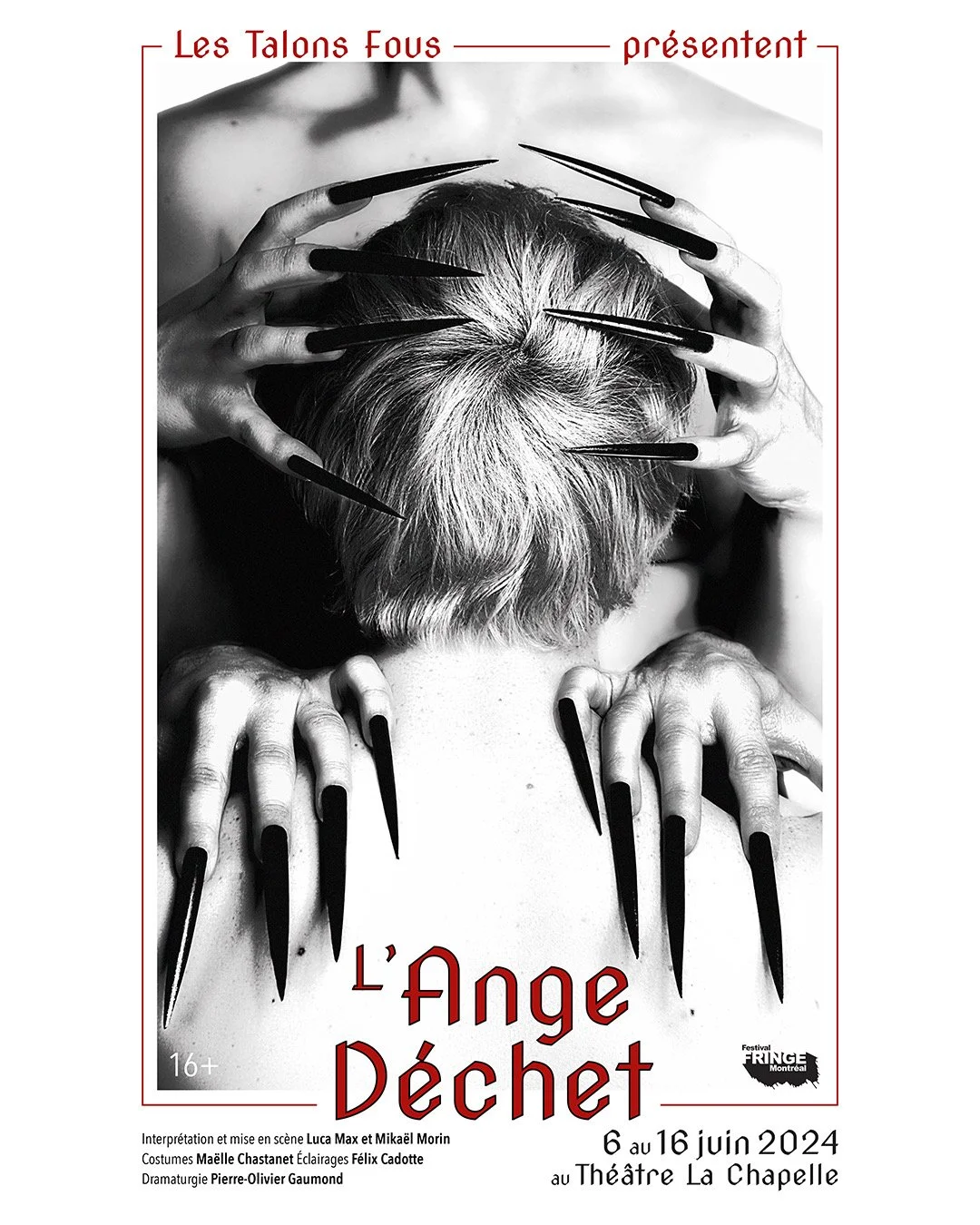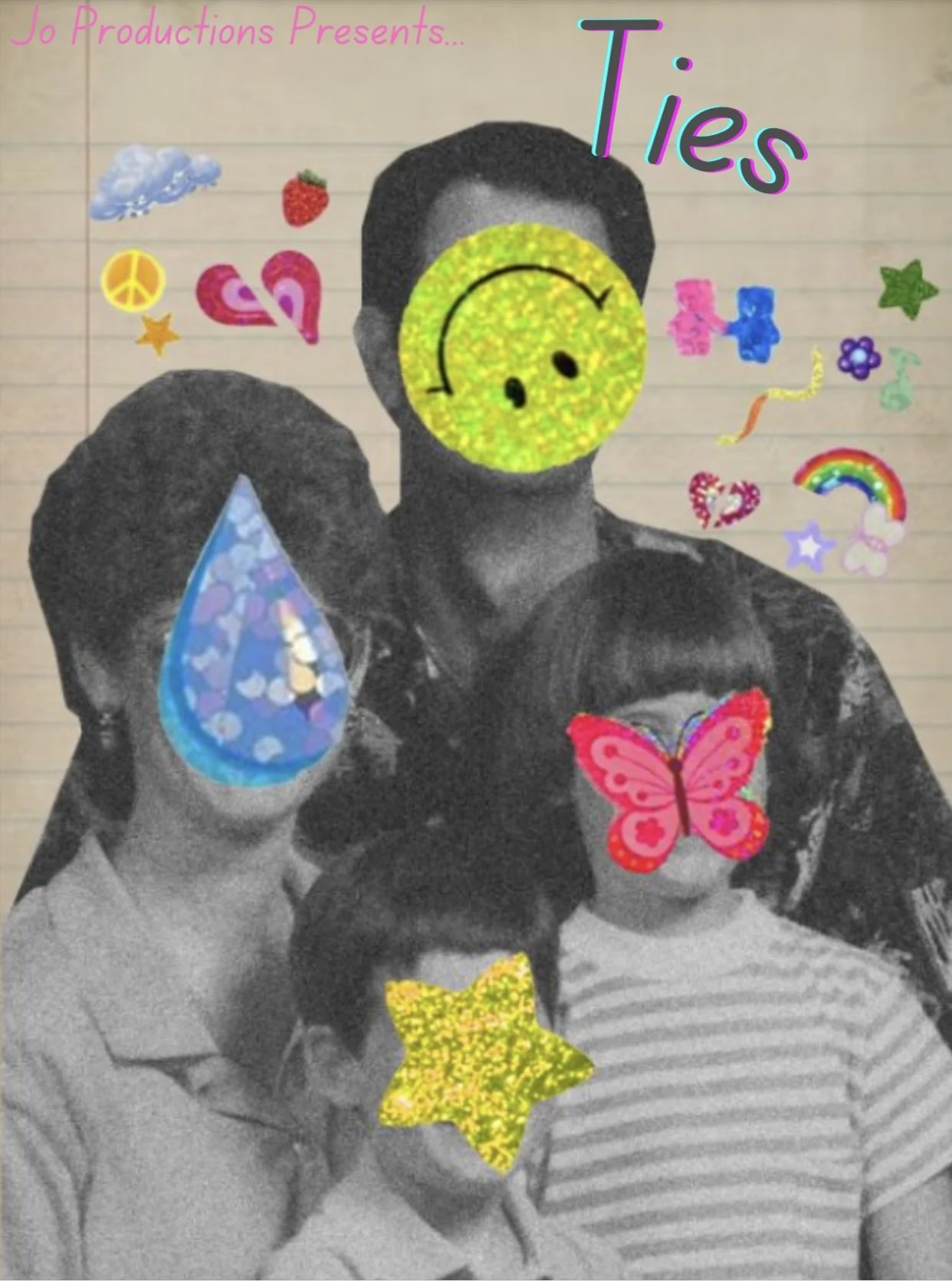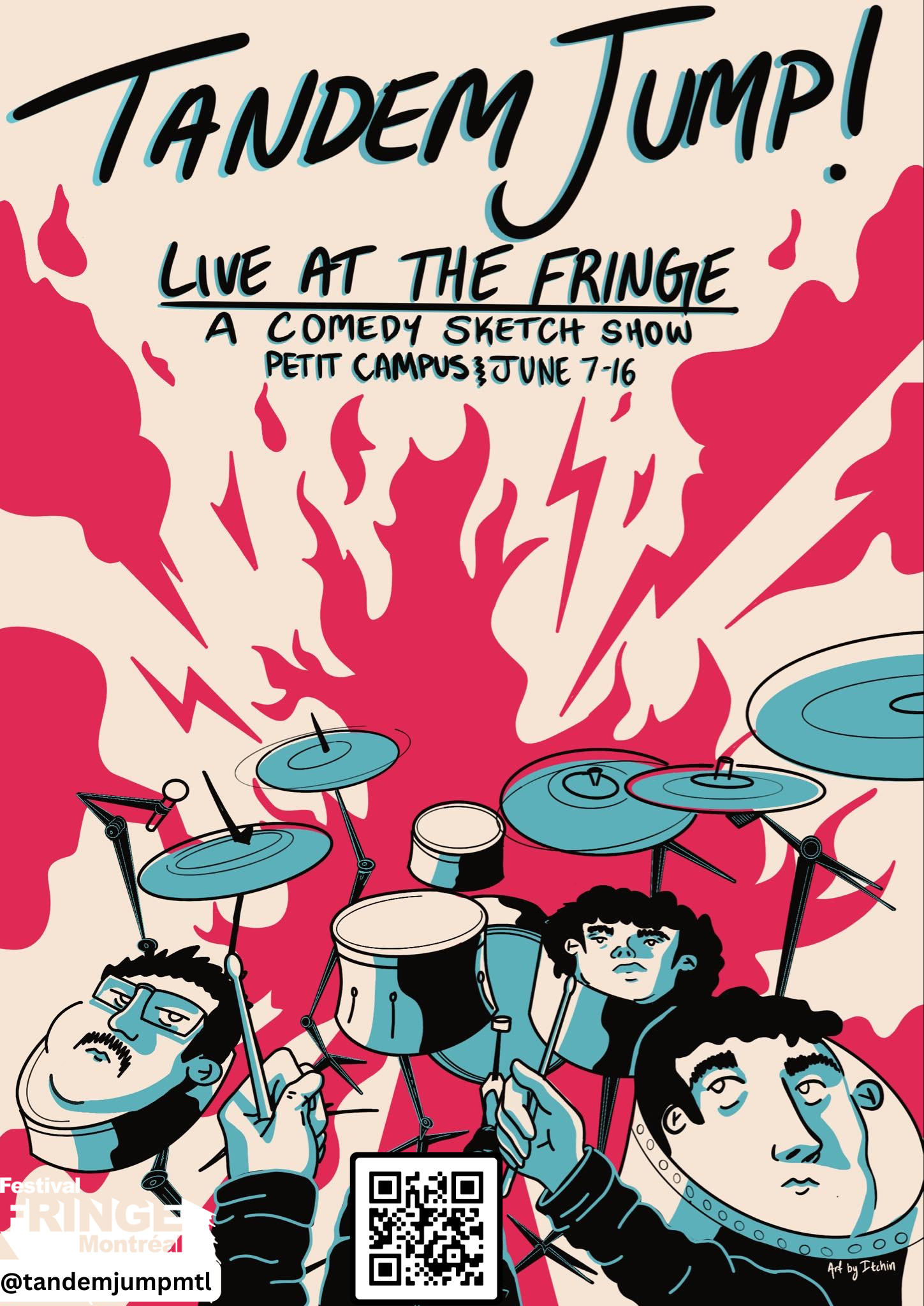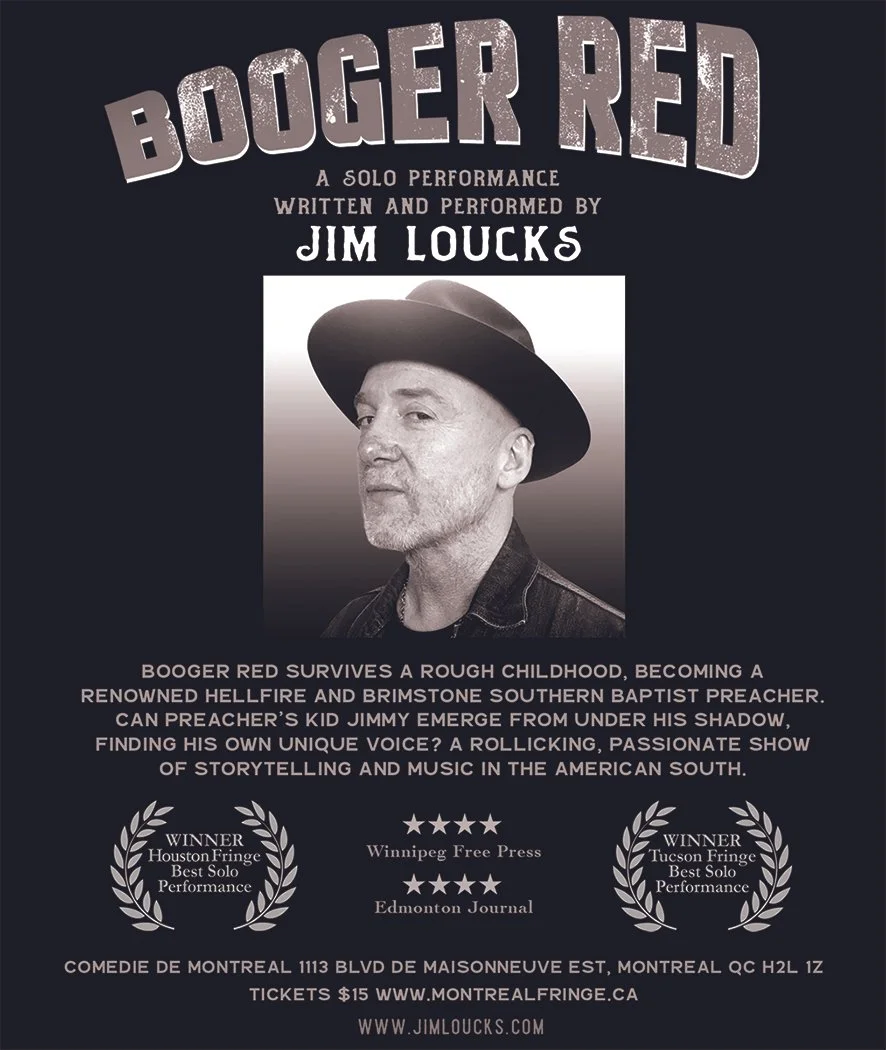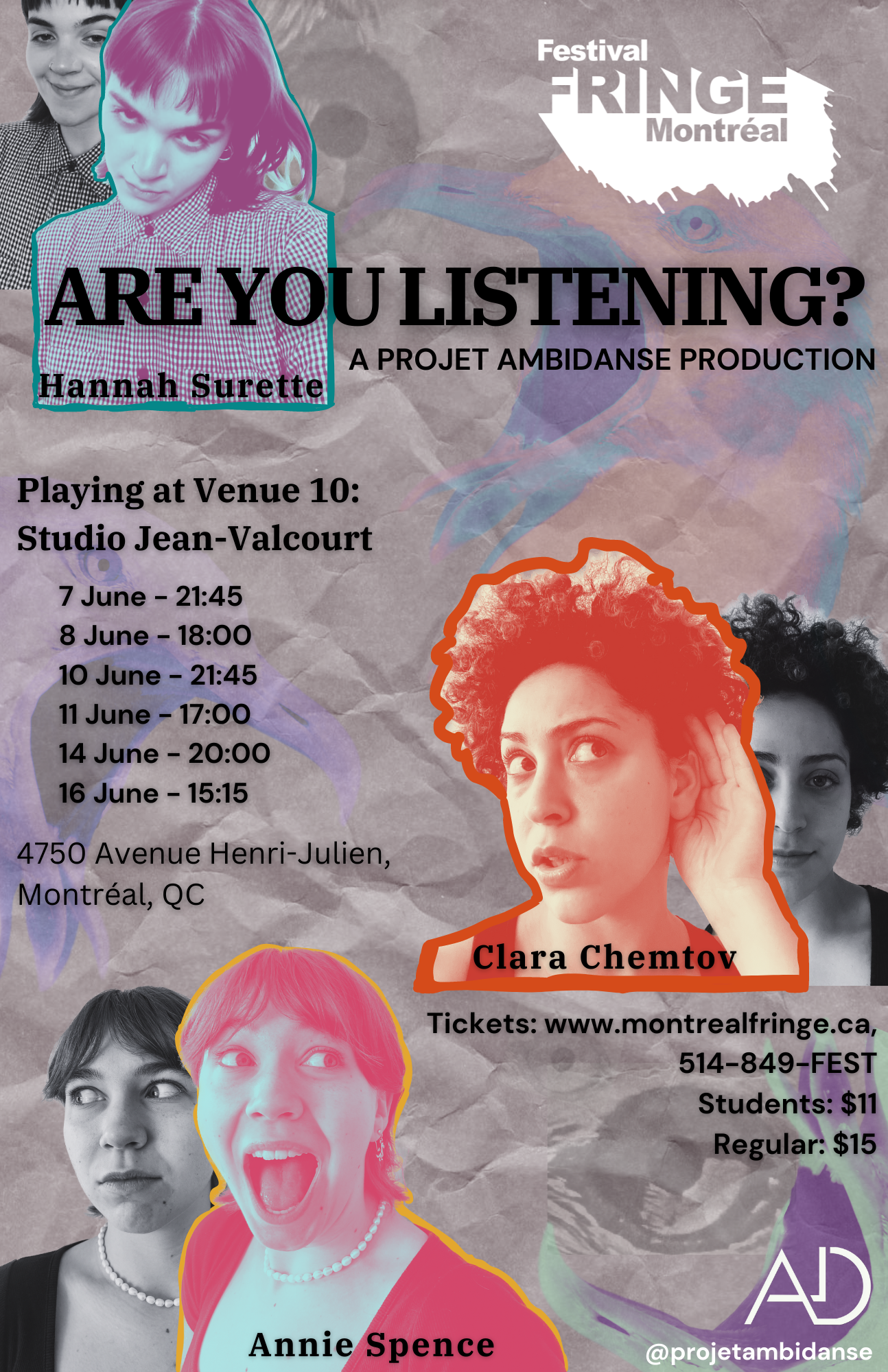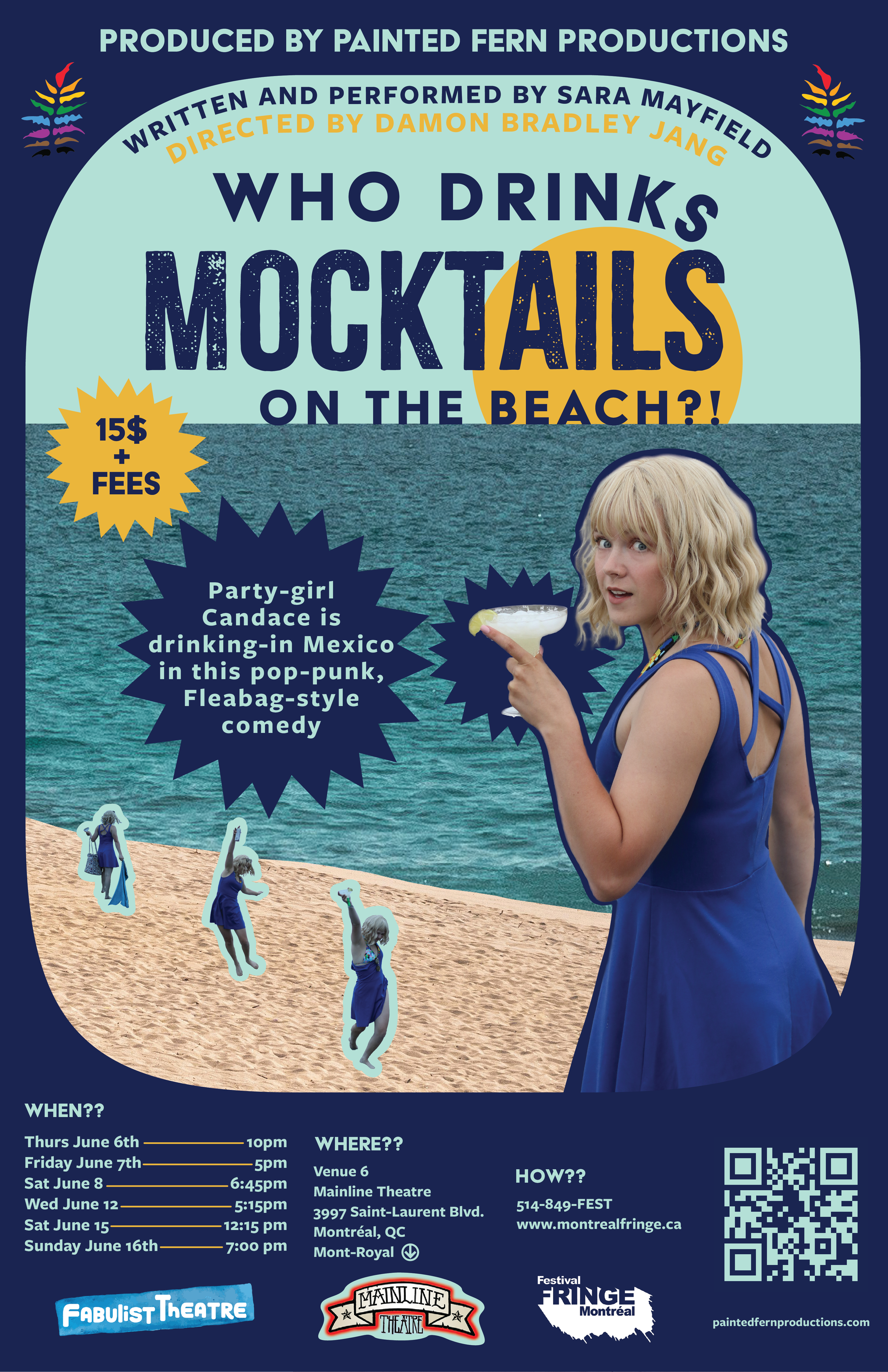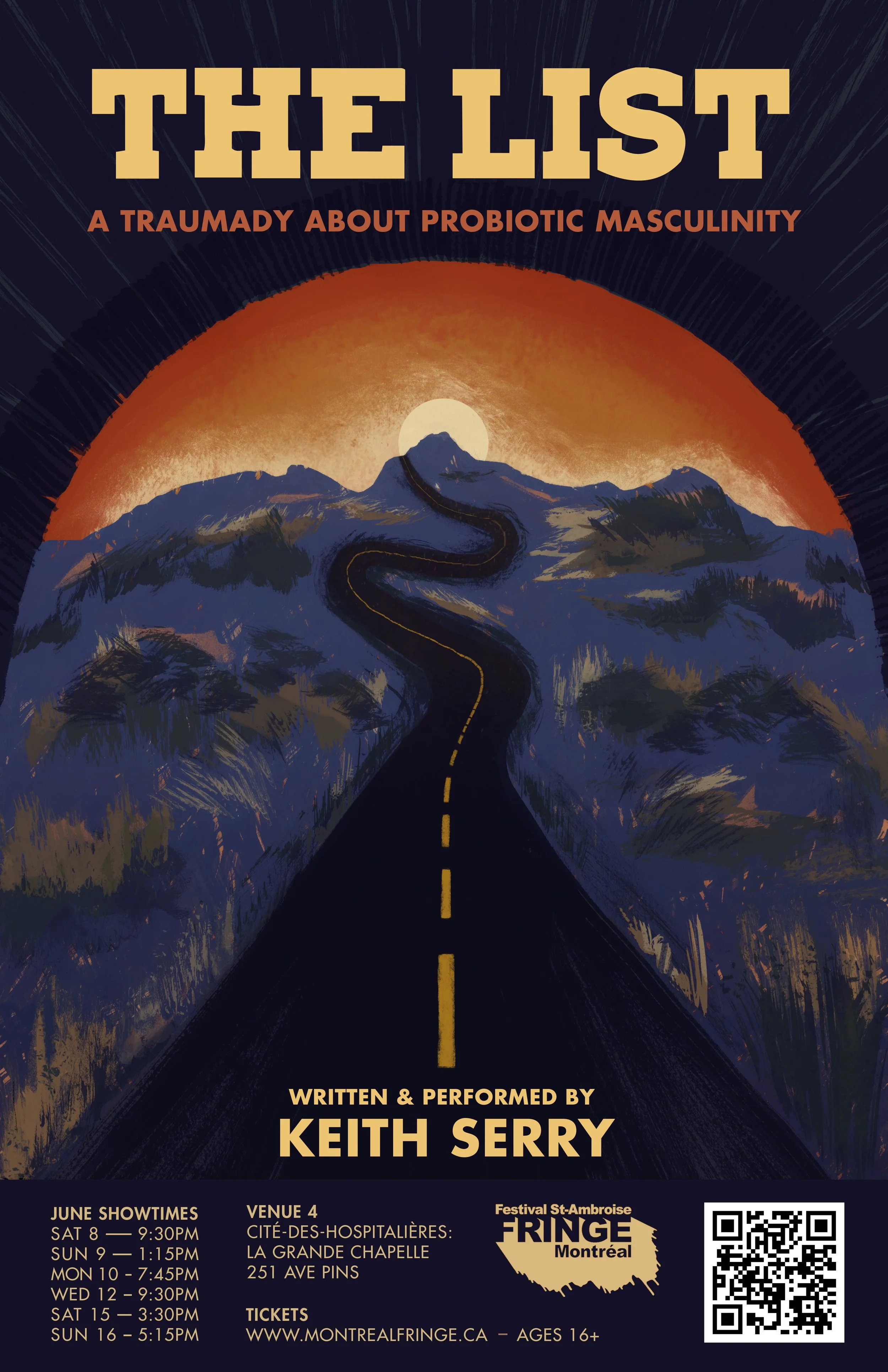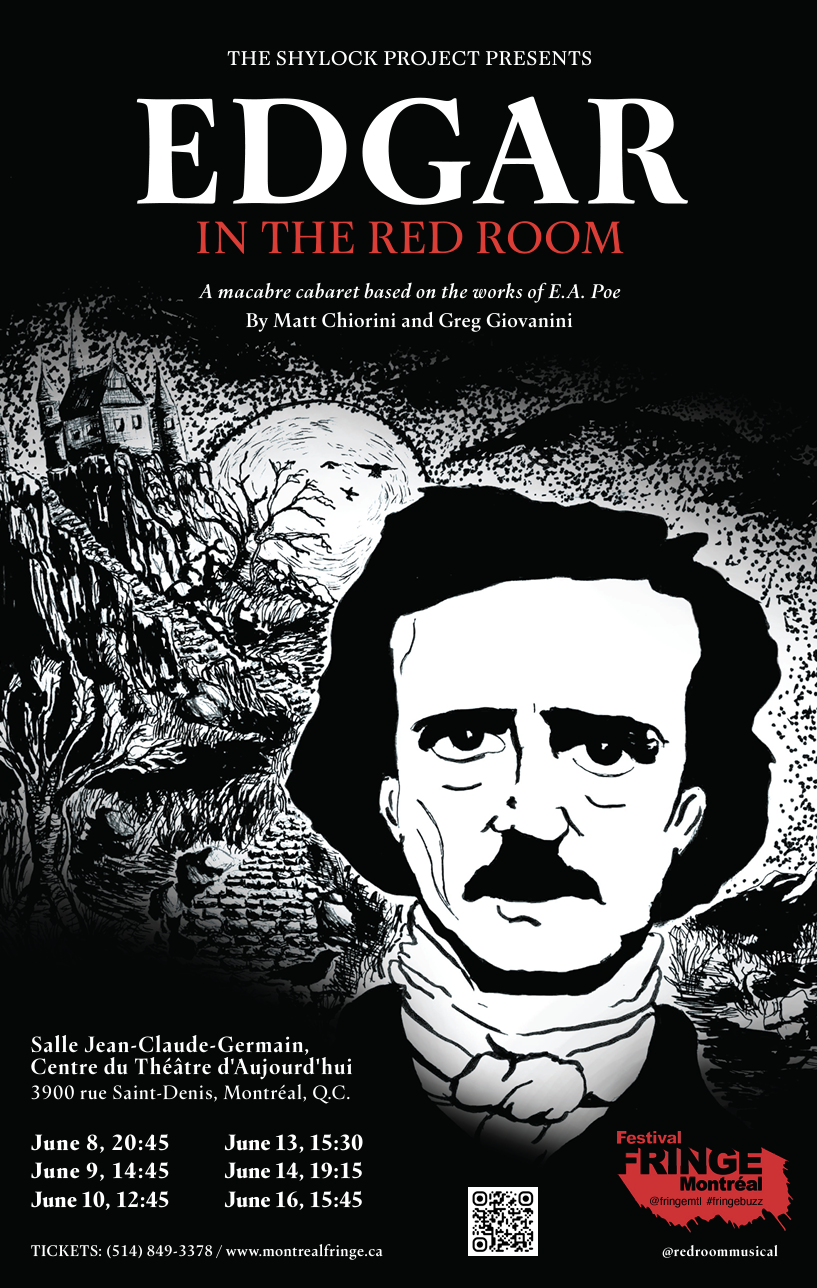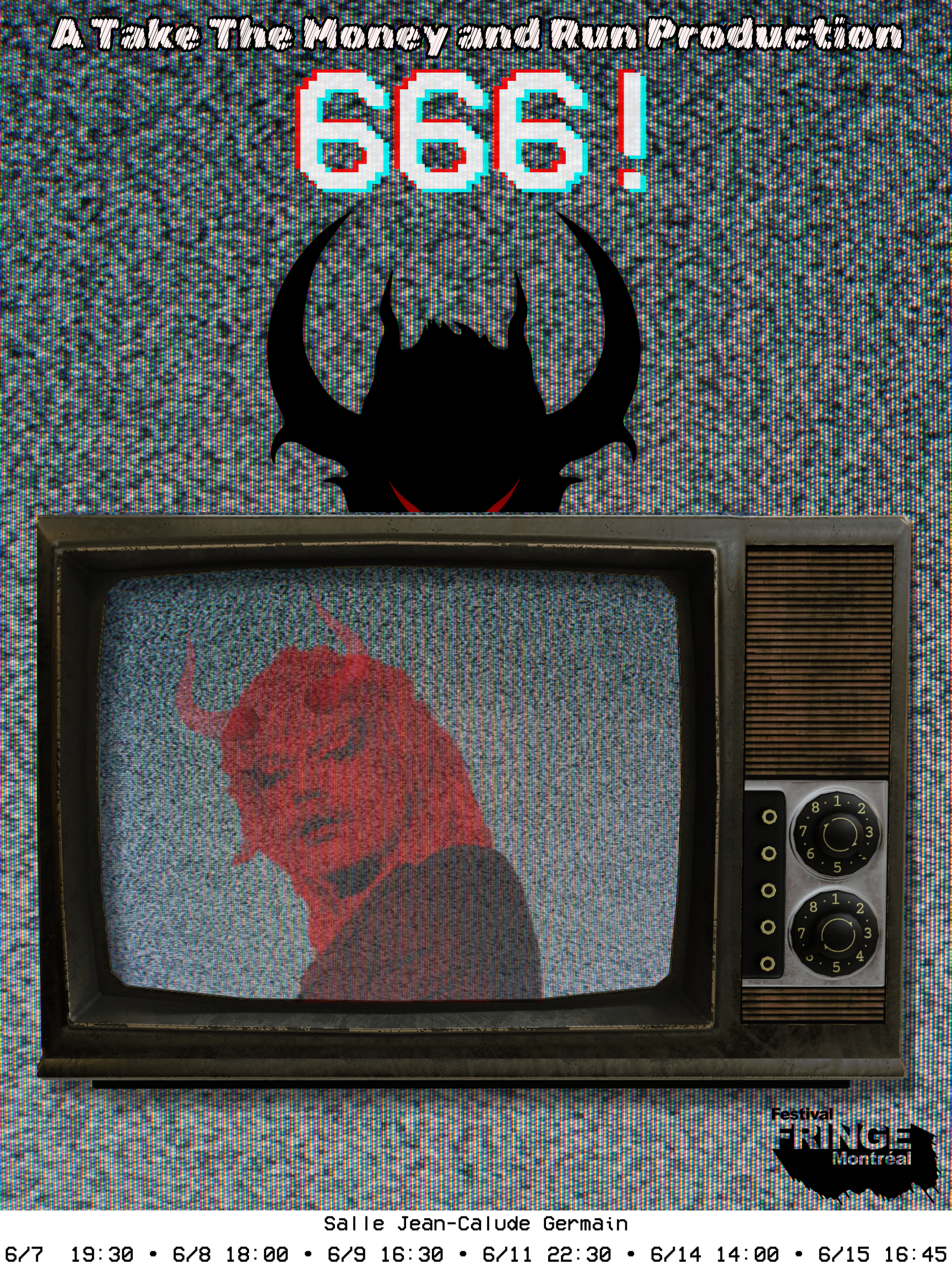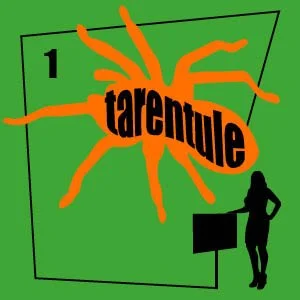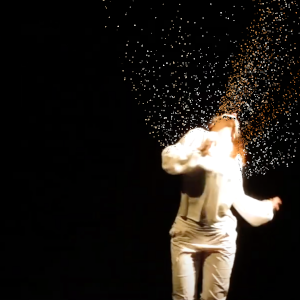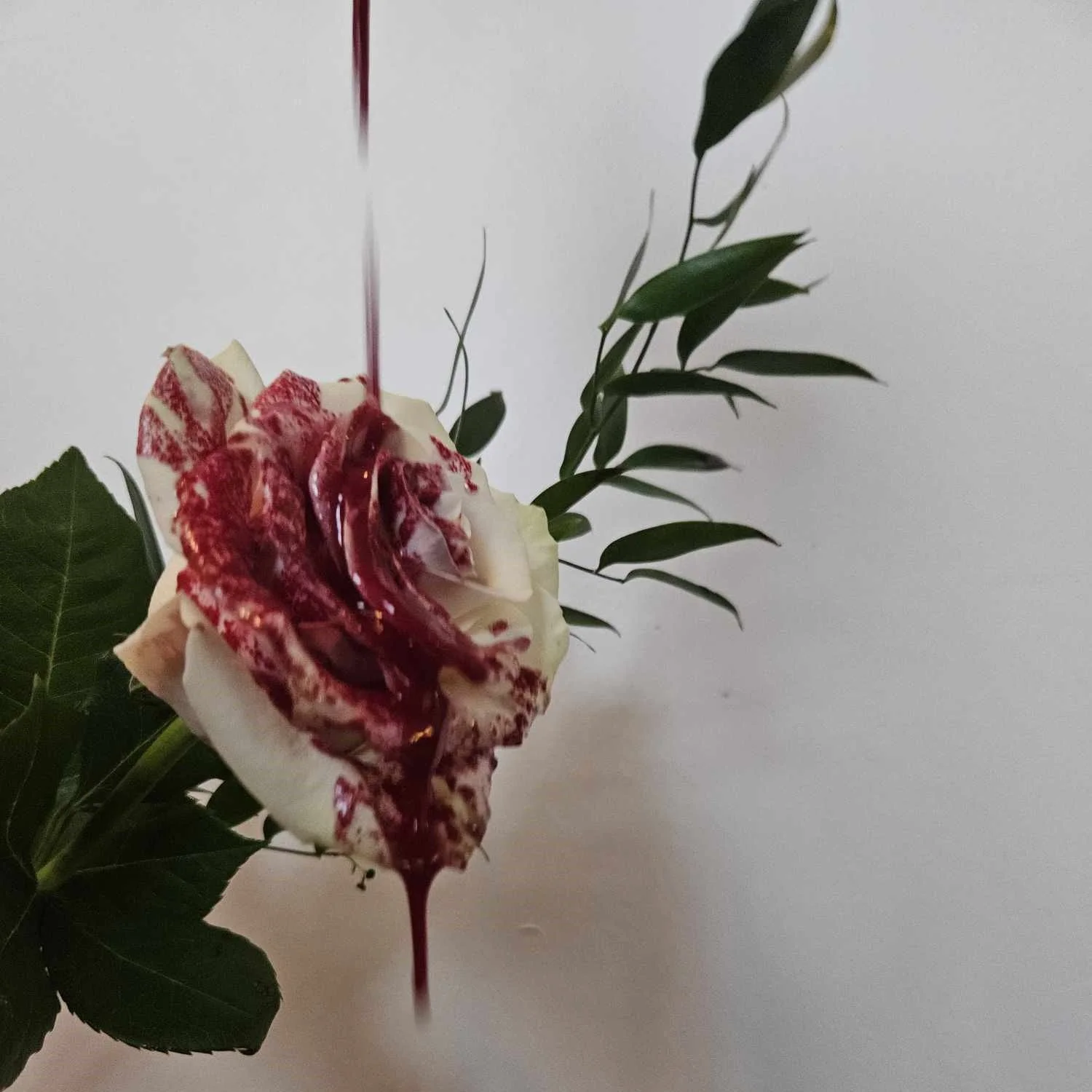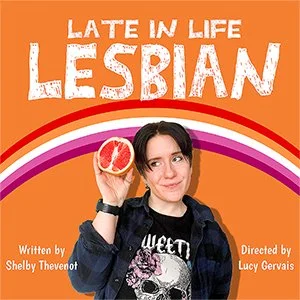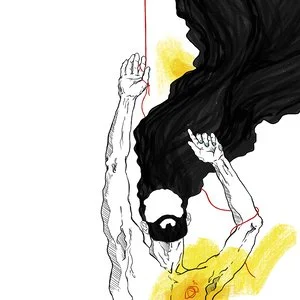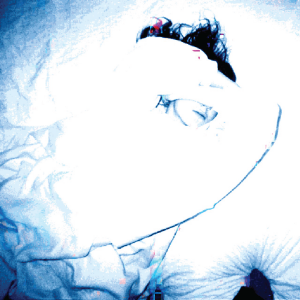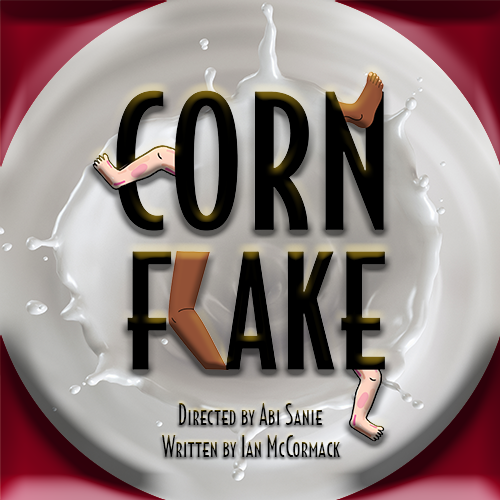Andrew’s Reviews
Jimmy Hogg: The Potato King, La Germaine et Le Vieux Criss, and Beyond Ken Dryden.
Jimmy Hogg: The Potato King
Montreal’s erratic weather never disappoints, and Friday night was particularly manic. The rain poured, then stopped, then poured again, then stopped… I was particularly damp as I arrived at O PATROS VYS for Jimmy Hogg’s 10:15PM performance of The Potato King. Now, don’t get me wrong, I enjoy American (Canadian) comedy. Observational humor and witty one-liners are always good for a laugh, but I’m particularly fond of the dry wit, the clever sarcasm, and the awkwardness of comics from the UK. As such, I jumped on the opportunity to review Jimmy Hogg’s production when presented with the opportunity. Described as… well… nothing, I walked up the stairs to O PATROS VYS with only the knowledge that the show contained potatoes and some mime. I quite like potatoes, but I’m not that fond of miming. But Jimmy isn’t French, so I’m sure it’ll be amusing. (Spoiler: it was.)
When it comes to FringeMTL, it’s difficult to say that any venue is perfect, but the setting for The Potato King was as close as you could get. The room isn’t small, by any means, with cabaret-style seating, and longer bar benches and higher seating toward the back, closer to the bar and soundbooth. The lighting was simple, a soft wash across the stage, and the set was even simpler: a single chair, rarely used, and a mug (which I hope was filled with bourbon) on top of a speaker, stage left. This was all that was needed, because everything else on the stage in this 60 minute performance was generated by the thoughts and words of Jimmy, and I can guarantee that everyone could see the set pieces and characters as though they were genuinely present.
Jimmy begins the storytelling with an anecdote about his mother losing her virginity, setting the tone of the evening with concrete certainty: this is going to be a wild ride. “It’s a love story” he tells us, as he pushes through to the protein of the piece. Jimmy Hogg’s energy is seemingly boundless, and while that Friday night the room may have been half-filled, there was no space that he didn’t occupy. Simultaneously charming and chaotic, Jimmy’s movement around the stage is not just an outlet for his energy, but him creating, building the set pieces for the stories he weaves about love, loss, potatoes, and risotto. The latter being anchor points in stories about ex-girlfriends, ones who have no taste, ones who have no sense of time.
Jimmy Hogg’s passion for food had me in stitches from the earliest moments of the show. From knife skills to meat selection to wine pairings, he expressed his love for the finer aspects of cooking. Watching him work up a sweat while lecturing the audience on the proper way to cook risotto had me cry-laughing so hard I couldn’t take notes. Some of Jimmy’s references are universal, and some are niche, and that’s okay he reminds the audience as I’m the sole person to laugh at a joke about Brecht. “Try not to be so selfish,” he tells the women at the front, “not everything is for you.”
Sixty minutes is a long time to be alone on stage, and the text of the piece was extensive. Yet Jimmy managed, on his opening night, to execute flawlessly (at least, from where I sat). I could write much more about this production. I’m grateful to have seen it. Jimmy Hogg is an absolute professional, and his command of the stage was on display in full force. He is a man panicked in the face of the absurdities of our daily lives, and yet I left with a renewed sense that everything will be okay, especially if we can laugh.
La Germaine et le Vieux Criss
For my third visit to the Cité-des-Hospitalières, I was grateful to once again return to the Chapel. Previously having attended a dance performance here, I was excited to catch something spoken, La Germaine et Le Vieux Criss. The chapel is a beautiful, if not slightly cavernous, performance space, and I was curious how a one-woman production would handle the size. The rain had stopped long enough for me to walk over to the venue early enough, and when I arrived I had plenty of pews to choose from. Predictably sitting further back, into the darkness, I opened my program to refresh my memory. The play is written, directed, and starring Alexia Côté, and that’s an enormous undertaking. The story follows Béatrice, who works at a CHSLD, and her visits to a psychologist mandated by her employer. At once the piece examines some of the darker aspects of our healthcare system, the decisions we make (and the impact they have), and the fragility of life.
The stage, the altar at the front of the Chapel, was comfortably bare. At the centre were two wooden chairs, side by side. Flanking those were two podiums, the one on stage left holding a golden box (unused through the production, which I found curious) and the one on stage right holding a thin microphone. A table with the show’s tech sat in the liminal space between the audience and stage. One would think that inside an enormous chapel with vaulted ceilings that this stage design would be lost, and yet my focus was easily pulled to the centre of the stage, centre of the story, by the incredibly talented Alexia Côté. Credited as a multi-disciplinary artist, Alexia managed to fill the stage, refusing to let you look anywhere else. This was helped by the fact that we the audience play the role of the psychologist, with our main character often sitting centre stage addressing us directly.
I know I’ve already said it in this review, but Alexia Côté is a powerful performer. My understanding of French is intermediate, it’s not perfect, but I didn’t miss a thing. Expecting something more dramatic, I was pleasantly surprised to experience as many laughs as I did. Alexia doesn’t allow the audience to sit in sorrow, but rather laugh through it, if possible, whenever possible. While her voice was infrequently lost to the Chapel, as many others in this venue have experienced, Alexia didn’t need to rely solely on her words, with her staging making it abundantly clear what the character was feeling and experiencing in each moment. The sessions with the psychologist, broken up by brief music interludes, allow us to track Béatrice’s life, making us very present with her during a heartbreaking climax.
La Germaine et Le Vieux Criss is nothing like what I expected, and I mean that in the best way. My heart was filled with joy, with sorrow, with understanding. Due to Alexia Côté’s writing and performance, I feel like I had the blessing of getting to know another human being, to make a connection, one I wouldn’t have otherwise experienced. This is a French production, yes, and while Alexia may have a habit of speaking quickly, as many French Canadians do, I can say with certainty that you don’t have to understand every word to witness, and be moved, by this moving piece of theatre.
Beyond Ken Dryden
My father was a pro hockey coach. Growing up with personal relationships with many players that my friends idolized was strange, I’ve never been able to relate to that sort of admiration. So, I’ll make this admission: I wasn’t entirely thrilled to see this production. But here I am, writing to tell you that I was pleasantly surprised. In fact, I came away with a much greater understanding of how and why we behave in this strange way, idolizing pro athletes.
Walking into the Conservatoire de musique et d'art dramatique du Québec for a Sunday matinee, I was impressed by the size of the audience, which was nearly sold out. I took a place near the front of the stage, which was sparsely set: a metal folding chair at centre stage, a hockey stick, and two tennis balls. Written by Oren Safdie, and performed by the wickedly talented Max Katz, Beyond Ken Dryden is a nostalgic journey through the early 70’s in Montreal, with 1971 being a very important year in the author’s life: this is the year that Ken Dryden began to play for the Montreal Canadiens.
While Max Katz is certainly not 7 years old, he is filled with child-like wonder, and an infectious frenetic energy. Safdie uses the backdrop of his growing love of hockey, and his hometown team, to guide us through troubling aspects of his young life between the ages of 7 and 14, ultimately leading to the drawn-out divorce of his parents. Katz bounds around the stage relating hilarious stories of Safdie’s relationships with his mother and father, his grandfather, and his sister, while also documenting the loss of innocence (and attempts to understand this) through crushing tales, like discovering his father’s affair at a very young age.
While the set, and the lighting design, are simple, sound cues are used regularly. We hear roaring crowds of Canadiens fans, play-by-play commentary on both the radio and television, the latter of which wasn’t actually there, but sat down stage centre when necessary. The text of Beyond Ken Dryden is expansive, and Katz rarely stops speaking. Yet, he never stumbles, never falters (at least not noticeably), leaving me in awe.
This production is about much more than hockey, and about much more than family. This is a story about the shared human experiences of sadness, frustration, confusion, anger, and how and where we find escape, where we find happiness. As I mentioned, Sadie helped me understand the motivation behind a person’s admiration for a sports team, or a particular athlete, and for that I’m grateful. The fact that I reached that understanding through a well-written and expertly performed play? That’s an overtime goal.
L'Ange Déchet
First, I want to make clear that I do not believe this show was for me. In that, I mean that I am not the target audience. I am a Queer artist, yes, but Queer art is not a monolith, rather an incredibly diverse patchwork. For myself, I yearn to experience Queer art that isn’t hyper-focused on sex. In my own work, the sexuality of characters is incidental (and likely fluid), with the story being told given the majority of focus. But, that’s myself, my work, and as I mentioned, not everything is for everyone.
I kept that thought in the front of my mind as I approached La Chappelle on Wednesday evening to catch L'Ange Déchet, from Les Talons Fou. This production is a prequel to their work in last year’s Fringe festival, Le Fruit Défendu. Described as circus and pole-theatre, the piece promises to deliver a story about Samael, a fallen angel, and the influence of Lilith, upon meeting her in Hell.
The theatre was nearly full, and I tucked myself away at the top of the crowd. The buzz of Fringe was in full-swing, as conversations revolved around what have you seen?, and what are you going to see?, with the occasional I heard that was so good. As the lights dimmed, the anxious crowd began to applaud, before the show began. While I may not have been the target audience, they certainly reached theirs, as the theatre was filled with positive and supportive energy that was incredibly infectious.
The movement, the dancing, the pole work, all were flawless. The skill and talent of both Luca Max (Lilith) and Mikaël Morin (Samael) were on full display. As the duo not only starred in the production, but directed and wrote it, it’s clear that they’re both very aware of their abilities and limitations, and they presented to us their absolute strengths on stage. While there was less circus than I’d expected (although, really, what was I expecting?), the physicality of both performers contributed to a visually stunning piece. Particular appreciation to Max, as Lilith, who spent the first part of the production as a quadruped. Morin was crackling with energy as Samael, using his body to tell the story of an insecure, anxious, scared character coming into their own, finding their confidence, finding their voice.
The beauty of FringeMTL is that a production may have the opportunity to run in a venue that may not have otherwise been available to them. La Chappelle is no exception. The stage is enormous, the tech is excellent. (The seats leave something to be desired.) Predictably, red lighting was used throughout the production, as the setting was Hell. Accompanying that, though, was a beautiful soundscape throughout the piece, giving the sense that the location was not only terrifying, but expansive. The narration, while integral, could have benefitted from a more articulate and commanding voice. But that can be quickly overlooked once Donna Summer begins to play. (Twice.)
Ultimately, the piece is great fun. It charges full speed from start to finish, with the confidence of a production that’s run for years. I attribute that to the work done by Max and Morin, who clearly have an inspiring collaborative relationship. As a bit of a religious scholar myself, I was anticipating something more Biblically-focused, or accurate, but the production’s relationship with the source material is loose, at best. However, L'Ange Déchet delivered on its promise of entertainment. Between the pole dancing, the real dancing, the physicality of the performers, and the comedy, it’s hard to imagine anyone not being thoroughly entertained, whether you’re the target audience, or not.
Dawn’s Reviews
Me and Her, Mom Ballet, and Love, Sex, and Frenching.
Me and Her
Finally, a reason to check out the Cité Chapel. I've already been smitten with the architecture and history of the site, but for a multitude of reasons, I don't stroll into chapels without cause. Entering this one reminded me that I should. While Andrew had already waxed poetic on describing the place to me (and to you, read it here), nothing could do it the justice of being there. It's much bigger than I expected, ornate and warm, and I wonder what distinguishes a chapel from a church (I'm sure Andrew knows). Regardless, this is the perfect stage for a show about waiting for death, the passing, and the lives that continue in the aftermath. Written and performed by Caroline Gauthier, this is a personal view of a universal experience, the death of a parent.
The minimal stage design is a multitasker. Indian textiles hang in the background. The covered theatre cube at centre stage serves as her mother's deathbed as well as a seat on a tumultuous bus ride through India, for instance.
From a technical standpoint, the space created an echo as Gauthier moved across the stage, which was a bit tricky. Her words risked being lost in the reverberation, but thankfully never fully were. The off stage sound effects shone in the chapel: when the chaotic traffic was called for, the horns and engines sounded realistically overwhelming. When the sounds of drums and ragas came through they were rich and resonant, washing over us and filling the room all the way to the domed roof.
The lighting was imperative. As there were no scene breaks, the shifting colours and brightness served to denote changes in location, mood, and travels through time. Gauthier both narrates and performs, fluidly switching from what sounds like a diary entry to being in the moment she was describing.
It's a story of love, loss, suffering and survival; a timeless tale we all have a version of, and this is distinctly Caroline's. From her hometown to the pyres of India, Gauthier follows her deceased mother's footsteps in her own fashion. Perhaps most importantly, she discovers along the way that while death is universal, the way we perceive it is quite cultural…And what we do with the life we have left is in our own hands.
Mom Ballet
The set is all fantasy pink. Bright pink door, shimmering pink shower curtain, pink accessories on the sink top…and a white toilet. Molly (Sabrika Leduc) appears, and a voiceover begins: a man and woman discussing whether or not to have a child. It feels like she is the woman in the conversation, but she stands, silently looking into the audience. And then, she begins to dance. So begins Mom Ballet, Slippery Moon Productions Fringe offering.
Considering the cultural importance of women's bathrooms (think strangers supporting each other and passing along hygiene products), setting the play in the home's washroom was a stroke of genius. Here Molly has the privacy to shed her tears, voice her fears, and share intimate, honest moments with her two daughters, Chelsea (Jacqueline Trudel), and Bella (Zoe Venema).
Never have I seen so many costume changes in a Fringe show, and my eyes were delighted! Aesthetics aside, the quick changes provided context for the moving of time, as we never leave the bathroom. The world continues beyond that door, but this is a space of contemplation and questioning.
Every woman faces the question of whether or not to have children, and when we do, we also understand that some decisions are made to the exclusion of all others. Molly weighs her business, her love of dance, wondering if she can in fact have it all. The moments of dance are compelling, expressing all those words that cannot do justice; fear, longing, passion, hope. It was my first time seeing live ballet en pointe, and it was the perfect metaphor, each move excluding the option of another. The sound of Zoe Venema’s shoes against the concrete as she floated across the stage reminded me that all that elegance, all that grace, takes immense fortitude of body and spirit. The things that look easy rarely are, and sometimes in creating the illusion, we tear ourselves apart.
The soundscape was perfect, with sound effects expanding the world both within the sanctuary of the bathroom, and on the other side of the door. Musical director and acclaimed guitarist Ioana Gandrabur provides live accompaniment, allowing the dancers to fully embody the moment.
Jacqueline Trudel and Zoe Venema are perfect in their roles. Their dance was mesmerizing, and their acting was just as good. Their characters are sides of a coin as Molly struggles with inner conflict. Sabrika Leduc truly inhabits her character, showing both strength and vulnerability as she struggles to decide what her future will be.
I left feeling connected to all women who face this decision, and those for whom the option was never provided. Highly recommend. Hot tip: get in early and grab a seat up front to catch the fancy footwork.
Love, Sharks, and Frenching
The vibe on St. Laurent on Saturday night was perfect. Sure, it was colder than we wanted, and wetter too, but it hardly dampened the party spirit. With Mont Royal avenue closed to traffic for the season, and St. Laurent closed for Mural Fest / general street party, it was the perfect night to be out, weather be damned.
Besides, I had a hot date. Love, Sharks and Frenching: A Hot Date with Lou Laurence, is a one woman show filled with storytelling and musical comedy. There was a sizable crowd at Petit Campus to watch Lou do her thing. It was the youngest crowd I've seen at a show so far this year, and the first time this season that the crowd seemed to be there specifically for the star. Tables of friends and couples leaned in smiling, and expectant, and she delivered exactly what they wanted.
Lou Laurence is a Montreal-based singer, comedian, songwriter, and improviser. Having studied both musical theatre and creative writing, she combines all her training into a show of conversational storytelling, musical comedy, and improvised songs.
Laurence's voice reminded me of Canadian darling Serena Ryder, rich and strong with impressive if understated control. I say understated because her voice felt free, like belting out your heart alone under the stars, but it was always precise, her modulations smooth. She was comfortable on stage and never lost the audience’s attention, flexing her professional theatre training. At the table next to me, I heard a woman loudly whisper “she's so good”.
She took suggestions from the audience, crafting catchy, funny songs on the spot. It's a skill I envy, and I always enjoy seeing it done well. Laurence definitely has a knack for it, and it was my favorite part of the show.
I don't remember the stories she told, and I think that's intentional. They were casual, small stories, the kind we share over coffee, but they created the context for her songs. Her style and voice are the stars here, the rest is the backdrop for them to shine.
Vehicle
Heading to Petit Campus for the second time in less than 24 hours, I mix things up and head over via St. Denis, cutting through St. Louis Square. The sky is a foreboding grey over Sherbrooke, and sunny blue toward Mont Royal. The ground is already wet, but the sun is bursting through as I walk between weather systems.
It's always a bit odd to be in a bar in the daytime, but thankfully Petit Campus blanks out the outside world, wrapping you in whatever’s happening there. I arrive early, which gives me a chance to watch the crowd trickle in. It's the most age diverse crowd I've seen so far, tables of youngsters and OGs setting up in groups until the room is nearly full. It's a great crowd for a Sunday matinée, and the energy is bumping. I get the impression that everyone knows who they're here for, and they're psyched. In fact, as the stars Shane Adamczak and Sam Longley take the stage and applause breaks out before the stage lights are up.
Shane and Sam are award winning Australian actors who have toured for decades. Their talent and experience are evident off the bat, captivating the audience immediately. From the first laugh, I knew I was in the right place. It's billed as a meta-comedy, and the lines are beautifully blurred from the start. The script is clever, funny, and filled with interesting stories, making it my favorite show so far this year.
The backdrop is a projector screen, and the first thing we see is a quaintly drawn road on lined paper, moving as the stars drive their invisible car. The props in the show are a combination of mimed and real, a fact that the characters both address and explain. It's technical fodder that allows the meta to flow freely, and I was absolutely tickled.
Adamczak and Longley have great chemistry, and it was a pleasure to watch them together. There were moments that may have been improvised on the spot, or may have been so skillfully acted that they just appeared as such. I really want to tell you a bunch of their travel stories and jokes, but that would defeat the purpose. It is however, important to note that days later I'm still thinking of this show, still bubbling with giggles, still thinking about the tales they told. I think it's safe to tell you that at one point Sam asks the audience if he can drop the fourth wall for a moment, and then admits he'd never really put one up. That's the stuff that makes me gigglesnort with abandon.
While there are deliciously absurd moments that would likely make Monty Python proud, there were also tender, serious moments. Both sides of that coin, the whole proverbial wallet in fact, was so well done that I can't recommend it highly enough. If you see one Fringe show this season, make it this one.
Hedwig and the Angry Inch
Wait, Hedwig’s a punk musical?! Someone should've told me sooner. Ok, let me rewind.
Hedwig and The Angry Inch is a book, a movie, and a play, all with cult followings. Still, I'd not seen so much as a clip, and only had a cursory knowledge of the plot, making Keith Fernandez’s Hedwig my first foray into the story.
The show was at Monument-National, and my literal brain wondered what exactly it was a monument to. (It was built in 1893, and was originally the cultural centre of the St. Jean Baptiste society, and is the oldest theatre in Canada still running. It not only served as a stage for English, French and Yiddish performers, but it also housed Starland, one of the first cinemas in North America. Edith Piaf performed there. It's a historic site, a literal national monument. Ooooh, I gettit now.)
I walk into the room with just a couple of minutes to spare, and the room is filled with smoke. The band, led by Zoé Dupont-Foisy, is in full swing: keyboard, drums (Nicholas Baddely), bass (Ali Remondini), and electric guitar (Antoine Bensoussan), giving old school alternative vibes, and grungy goodness. They are the set, for all intents and purposes, fading into the background when need be, bringing the room alive when called upon. But when their pre-show song ends, the audience cheers, and the band stands, uncertain and silent. The smoke dissipates, and the crowd loses itself in chatter. Granted, the show hadn't technically started, but it felt like an unnecessary interruption in the energetic flow. The sold out crowd had already been enthralled, and had they kept playing, they would've been rapt.
The story is a good one. Botched surgery and unknown-rockstar life aside, Hedwig is recounting the twists and turns that brought her to where she now stands. Yes, some are sad, and some are funny, and isn't that the way? Alice Siregar, as the rockstar, was perfect. As her façade fell, layer after layer of her persona peeled away until she was just her honest, vulnerable self. And, as her truest self, she's able to grant space to her husband after all these years, finally allowing him to be his best self.
Now, the music was grrrreat, but so was the artistic direction and lighting design, by Sabrina Miller and Aurora Torok, respectively. The DIY vibes of Darragh Mondoux (as Yitzhak) moving speakers in real time, using an old school projector as a spotlight, it was punk AF, and I loved it. While I've seen Darragh host events before, I had no idea she could sing…and sing like that. Yitzhak and Hedwig brought the house down as the lights strobed and shifted. The show tipped into a full concert, and I was mesmerized. In fact, I'm going to check out the soundtrack, and I can only hope it's as good as this version was.
Jason’s Reviews
Cabaret of Murder, Comedy Game Showdown, Novacento: Pianiste, and Pindorama.
Cabaret of Murder
With a title like Cabaret of Murder, I was prepared to expect the unexpected. Still, I didn’t expect the show’s director, writer, and designer Blair Moro to kick things off with an announcement that one of the three performers was sick (Bella Ciccone), and couldn’t perform, and that their replacement only got the script two hours prior. Moro’s second announcement, clearly part of the show already, was not only expected, but appreciated. It was a content warning that stated that they, in no way, engage in any victim blaming, but also understand that this show isn’t for everyone, and people are welcome to leave if they find the material too disturbing.
The show was a deft mix of Verbatim Theatre and Cabaret. It’s as if a true crime podcast came to life and started singing and dancing. It featured statements and testimony from actual serial killers mixed in with performances of poetry, songs, and even short plays that other mass murderers wrote. After each performance, the cast informed us which killer made the statement or wrote the work, along with their body count, and whether or not they are still alive and in jail, haven’t been caught, or dead. So it’s educational, too. There was a really catchy song, Madman in Waco, performed in the middle of the show, that was, in retrospect, quite chilling. And I won’t spoil which killer wrote the two short plays that they performed unedited, despite them really needing an edit (which the performers acknowledged).
Kris Ma’Cheque, a drag king who is also performing solo in the Fringe show Personal Best, was the aforementioned last-minute stand-in for this show, and he didn’t miss a beat! Sure, you could see a script at one point,, but he brought the same energy and humour as Katie-Rose Connors and Paulina Pino Rubio, the two regular cast members. This didn’t feel like a stand-in performance at all. The trio moved effortlessly from one scene, and one killer, to another. While they were able to bring the required intensity and seriousness in the scenes, they also brought the much-needed levity between them. When the material is this dark, the Brechtian stepping out of character, and showing that we’re all just playing, was a nice touch.
I never thought I’d see a true crime cabaret, but now that I have, I can say that it works. The most disturbing thing is how easily some of the works of these killers lend themselves to the cabaret format. Cabaret of Murder isn’t for everyone, but it is a unique merging of style and subject matter that delivers what it promises.
Comedy Game Showdown
Some comedy shows are designed to be enjoyed alongside a loud, raucous crowd. Comedy Game Showdown, from Toronto’s And a Scotch Egg Productions, is clearly one of them. Catching it with a rather sparse crowd at Le Petit Campus at 10pm on a rainy Friday night did seem a bit odd. The show’s host and director Dan Donnelly commented on the crowd, or lack thereof, during his intro. He said that Fringe artists are no longer allowed to poster around the city, and then slid into one of my favourite bits of the show, which I won’t spoil, only to say that it revolved around a unique promotional strategy.
The format for the show was that of a classic trivia show, except without the points (until the very end, as a joke). The questions, along with graphics, showed up on a giant screen in the middle of the stage as Donnelly read them out. This was a multimedia show with a polished, professional feel. Like a TV or streaming show, which tracks, as they do record these and stream them. Two teams of two buzzed in, each trying to give the funniest answer, before Donnelly revealed the actual answer. I know that the focus was on the comedy, but I enjoyed trying to figure out the questions themselves. I didn’t already know most of the answers, even though several of the topic categories were Montreal-related.
The humour was, for the most part, light-hearted. Not quite dad jokes, but close. Nothing too edgy, except for one of the responses from contestant George Burgess early in the show. I felt, at one point, that I was at a JFL show, rather than a Fringe one. There was a definite Toronto flavour to the jokes as well, with a bit of Montreal anglo mixed in. Donnelly did live here for eight years as a McGill student. Burgess, his teammate Nikki Ashworth, and opposing contestant Joey Crewe are all Toronto-based comedians, but Crewe’s teammate Jacy Lafontaine is part of the Montreal comedy scene, and has even performed in the Candyass Cabaret. She got to stand up for our city’s bagels in one of the longer comedic debate segments following the questions. She stood up well for our better version of the bagel, while Crewe tried in vain to defend the New York variety, as well as NYC tap water.
This was a professional-looking show, with experienced comedians, and interesting trivia questions. The only thing it needed was more of an audience. But, of course, if this type of humour and presentation is your thing, you can fix that by going.
Novecento: Pianiste
I’ve seen plenty of one-person shows that include multiple characters in my day. They all have one thing in common: the actor will inevitably stop playing the protagonist and inhabit one of the other characters in the story, either through dialogue, costuming, or both. While that can usually be a nice touch, there was none of it in Novecento: Pianiste, the new Fringe show from De Anima Production starring, and directed by Laurent Orry from a monologue written by Alessandro Baricco. And I’m glad, because the show didn’t need it.
This is the story of Danny Boodmann T. D. Novecento, a stellar pianist who was born, lived, performed, and died on a cruise liner, never disembarking, even briefly when the ship was at port. He almost did it once, just to see the ocean from the shore, but couldn’t get past the third step. While Novecento’s story is a compelling one, that’s not who Orry plays. Instead, he plays a trumpet player who considered the pianist his best friend. It’s told from a place of what seems like recent loss. Or at least the memory is fresh, or brought back by drinking (he sips from a flask multiple times during the show). Orry delivers a captivating, emotional performance, which is only magnified by the choice to stay in character as the trumpet player, even when the focal point of the story, Novecento, is speaking.
While the set is minimal, with only a crate for Orry to sit on, one prop (the flask), and no costume changes, there is a rather intense storm at sea sequence aided by sound effects and lighting cues. But most of the scenes are painted through description. I could really see the scenes, both on the ship, and on shore. And I could easily visualize, and even hear characters like Nocvecento, the rich American passenger, and the man who claimed to have invented Jazz (the story is set primarily in the 1930s), despite Orry not performing them, only describing them and saying their lines.
It’s also important to note that this play is in French, which is my second language. I consider myself fluently bilingual, but I’m only 100% confident with my French comprehension when it comes to basic communication, fact-based articles, some song lyrics, and a decent amount of movies and TV. This was poetic, and delivered by a character in the 1930s, speaking from the heart, and correctly not taking the time to enunciate for the anglos in the crowd. So yeah, I did miss a few of the salient details. But it didn’t matter. The emotion was crystal clear throughout, and I understood what was going on even if I missed some of the finer points. And that’s just one of the many reasons why this is a one-man drama done right.
Pindorama
Pindorama by MBC Theatre is billed as “a very Brazilian comedy”. As someone not familiar with Brazilian comedy, I’m just going to have to take their word for it on that one. What I can tell from my own observations catching a Sunday afternoon performance at La Chapelle is that this is a very Fringe play, or at least it has all the elements I think of when someone says Fringe play. I know the festival has branched out to mean many different things to many different people, but for me, this is classic Fringe.
Playwright and director Fred Azeredo gave us a fun, fast-paced, outlandish story that still plays as reasonable. It’s surreal, yet somehow works as a believable narrative. And this is with some fourth-wall breaking in the staging, and a bit of it in-universe as well, a stuffed penguin other characters can hear, unexpected burlesque costuming, mythical creatures, and a full-on Jesus Christ. Religion plays a significant role in this story. The comedy is infused with it, along with disdain for a particular football (that’s soccer for us here) team. I really enjoyed how the plot got progressively more over-the-top in pace with the story and its characters moving locations. It was a nice bit of crafting.
For a show like this to work, it needs a strong ensemble cast, and Pindorama has it. Not only do they play their main characters, in some cases more than one, but they also double as time cues for the audience, boxing match-style. We get Mazdak Darvishi as the aforementioned Jesus, Alexia Maldonado Juarez as a nun interested in the occult, Jaanashee Punjabi as the ultra-religious bank secretary, Tessa Lupkowski as a secretary, and sometimes narrator (they also both inhabit other characters, Henry Kemeny-Wodlinger as a recognition-focused bank robber, and Daniel Wan…well, I won’t spoil things in this case with a character description. And it makes sense that all these characters find themselves in the same place, a bank, on the same day.
I could say, at this point, that I noticed elements in this show that could speak to the influence Brecht had on Brazilian theatre through Boal, but then I’d have to pretend I know something about Brazilian theatre, which I don’t. I could point out a Rocky Horror feel in the pacing, but there were no musical numbers. So I think I’ll put my early 2000s goggles back on and say that elements like stuffed animals, random sexy costumes, a walking, talking, comedic Jesus, and a narrative constructed to make that all make sense, mean that this is the quintessential Fringe show. And then I’ll take those glasses off, and say that this show is just plain creative fun.
Scotty’s Reviews
Attached, Ties, Tandem Jump Live!, Booger Red, and By Our Side.
Attached
Kerrin-Lee Whyte’s Attached, presented by Bioluminescence Productions, is a character study which looks at human connection through the lens of a seemingly upbeat university student and her social circle. It examines the dynamics of her engagement with significant people in her life: her best friend, her boyfriend, a new friend with a professional path that is parallel to hers, but most importantly, the person in her life with whom she is indelibly bound.
Having only been in Montreal for a few months shy of two years, I have found that walking through its streets while raining in the summer to be magical. However, walking through the streets of Montreal during a torrential downpour is not. I scurry to the side door of Mission Santa Cruz to the entrance of the performance space, shake off the water and wish I had spent a little more money on an umbrella as I notice I am thoroughly soaked.
After descending down a flight of stairs, we enter a large open space hosting an unlavish backdrop. During the play the set is just a few movable chairs, a blanket, and some seat cushions which is fitting, since the production’s focus is on a specific perspective on the roots of expressed behavior. The setup harkens back to Grotowski’s Poor Theater with the bulk of the process going into the acting, the story, and the heart. It is a Fringe Festival after all.
Director Casie Marie Ecker has an intriguing ability to craft frequent moments that are surprising and inevitable at the same time. For Attached, she cultivates an event that seems to test an audience’s ability to accept a “genre medley.” Ecker fully constructs and appends heartbreaking drama, psychological mystery, broad comedy, ritual, metatheatre, and a bunch of other incongruous stuff all “baked into a beautiful pie.” It’s there in the text and, sure, it’s been done before, but Ecker’s instinctive execution sets it apart from what this reviewer has previously seen. Her work on this production is not where theater is, but hopefully, it is where it is going.
Miranda De Luca and Cédrick Mulcair are immediately and utterly likable. Julie Pye is the epitome of an actor trusting she is enough, and Leopold Wambersie De Brouwer as Jack sidesteps the cliché of the toxic male. Kerrin Lee-Whyte brings a groundedness and simplicity to the ensemble as Xandra.
If there was anything that I questioned, it would be the abstract expression of a “sexual assault.” Not that it was abstract, but because even in the representation, it felt too safe. Structurally, there is a build that begs for a little more danger, a little more discomfort.
Quick research does not show that Kerrin Lee-Whyte has penned many plays before Attached, but there is an undeniable depth and understanding of dramatic exploration of the human psyche. Her work attempts to bring disparate pieces of a compartmentalized identity together in a compelling way. There were unfortunate time constraints, as is customary with Fringe. But hopefully in a longer version of the piece, time will allow more room for this. With that said, I would not say as a dramatic text it is perfect. Luckily, no one wants to watch “perfect.”
This review is glowing. The common precept is that if I write something that makes a work appealing to someone and they get a babysitter and pay for a ticket and don’t have an appreciation for the work, they will be upset. But you know what? I walked sixteen minutes in what felt like a monsoon to see this show. That trumps the hiring of a babysitter.
Ties
The intimate Studio Jean-Valcourt at the Conservatoire de musique et d’art dramatique du Québec hosts Ties, a devised theater piece which flips the traditional theatrical hierarchy on its head. As we settle into our seats, I find myself explaining the concept of devised theater to my companion, Aviva, a seasoned film and commercial actor. "Imagine the foundational elements of a theatrical production—text, plot, character, and so forth—as a pyramid. Devising theater turns that pyramid on its side, giving equal weight to each element. This means that movement, stage lights, costumes, and props are all on par with the text, allowing the ensemble to create a performance through collaborative contributions."
As the lights dim and the stage comes into view, scattered with seemingly random items—a plastic fish, some clothing—we are introduced to Jessica Rose and Olaoluwa Fayokun, who portray very young children in the opening moments. While I generally have reservations about adults playing children, Rose and Fayokun's technical prowess in movement and voice quickly dispels any doubts. The performance charts the lives of their characters from childhood onwards, seamlessly transitioning between brief scenes and visually stunning abstract interludes.
However, the abstraction sometimes feels directionless, highlighting the challenge of maintaining intention when movement holds as much weight as the text. Both actors demonstrate immense talent, yet there are moments where breath control issues lessen the overall impact. Performers sometimes use their breathing to generate urgency by frequently employing shallow, yet heavy, breaths. This sound can become somewhat distracting and is a pitfall, as the use of non-specific breath can create generalized emotion.
A standout moment arrives in the form of a conventional scene set at a funeral, where the actors' heart-centered performances truly shine. This scene underscores their capability to deliver deeply affecting work, a promise of their bright futures in the industry. Jessica Rose and Olaoluwa Fayokun are names to watch for those who appreciate skilled, heartfelt acting with depth.
Ties examines the impact of divorce on a brother and sister with a deft touch, steering away from melodrama and over-earnest sentimentality. The underpinnings are shaped by the performers’ keen insight that parental divorce might not be the ultimate crucible of suffering. This performative stance challenges traditional conceptions of trauma. Considering that theme, plot and character share status with movement and props (like a plastic fish), Ties is, by all accounts, a successful exploration of creativity in devising.
Tandem Jump! Live At The Fringe
Fun is not overrated. Having recently moved to Montreal, I found myself at Petit Campus for the first time, despite unknowingly passing by it countless times before. As I waited on the steps leading up to the stage, I took in the artwork, reminiscent of the Mad Magazine illustrations from my junior high days. The stairwell was hot and humid, and as I gazed at the trippy face drawing on the ceiling, I felt a twinge of vertigo. Perhaps it was the contact high from the super cool guys smoking outside the entrance when I arrived.
Stepping into the venue, I was relieved to feel the air conditioning and see tables and chairs instead of rows of seats, sparing me from awkward seating arrangements. It was F1 weekend, which had depleted my tolerance for crowds. The stage boasted a projection screen with two vertical streaks of light, and as people filed in, I surmised there were likely comedians among them. It gave me confidence that the evening's entertainment would be enjoyable. Being half Korean, I've learned that a Korean restaurant bustling with Asians usually signifies authenticity.
The opening standup comic took the stage with a great comedic persona and quirky material, maintaining a chill vibe even when the stage lights were prematurely dimmed. There was a friendly exchange, and he wrapped up smoothly.
As the main show began, it was clear what to expect when three guys in adult diapers, or what appeared to be adult diapers, with clear trash bags over their heads, entered. They portrayed aliens hatching through the plastic bags, wobbling around and exploring the stage with naive curiosity. It was stupid fun, but exactly what we came for.
The remainder of the show was a rapid, energetic succession of sketches. A few times the performers employed a vocal affectation reminiscent of a half-committed high school orator, yet it never grew stale. Some scenes were brilliantly absurd. Others take shots at over-earnest, socio-political metaphors, the “woke,” and pathos. I wonder if they know that pathos is just something that evokes emotion--which includes joy. A sketch comedy show has pathos…or we hope it does. They make a joke about getting grants. In the U.S. government arts grants are more for institutions, so it went over my head a little, but the other people got it and loved it. It’s fair to say some of the work becomes so chaotic it goes off the rails, and some of it is mostly purposely cringy, but the fact that they work together so well just makes it a good time. Oh, and there is a dick sucking joke! Who doesn’t like a good dick sucking joke?
In essence, the performance reminded me of the guys who, after a smoke session, dominate the PS5 lobby with their hilariously mean banter. Those are the guys that people want to play with. They have fun, so you have fun.
Booger Red
I'm a Southerner by way of Arizona, Oklahoma, and Atlanta since 2006. In Montreal, folks don't grasp what being raised Freewill Baptist entails, a term often met with disbelief in the U.S.
To grasp U.S. politics, one must delve into Southern evangelical churches. These pulpits preach blind faith, dismiss logic and science, encourage exclusion for unity, demand strict ideological adherence, and frame criticism as persecution. In small Southern towns, church membership is synonymous with respectability. Today, media giants like Fox News and Newsmax amplify this willful ignorance, turning it into political weaponry.
When we divvied up Fringe show assignments at Forget the Box, one description stood out to me: Booger Red. I heard, “Southern Baptist Preacher” and said, “That’s mine.”
Arriving at The Comedy Theater of Montreal, we took our seats and observed the colorful crosshatch backdrop. The lights dimmed, and a fiery sermon recording set the stage. Jim Loucks emerged, seamlessly continuing the sermon from behind a pulpit. For the next forty-five minutes, Loucks introduced us to the Southern characters who shaped his father, Booger Red, a nickname for troublemakers with his dad’s red hair.
Loucks, a natural on stage, inherited his father's commanding presence. His sermon recreations and hymns were unexpectedly endearing, hinting at a subtle critique of religion if a few dots are connected. His character work ranged from nuanced adjustments to exaggerated and hilarious caricatures. Loucks recounted his father’s tumultuous upbringing, filled with neglect and abuse ("He wasn’t raised, he was snatched!"), and his eventual path to preaching. He shared personal stories of his own rebellious youth, culminating in the revelation of his acting ambitions. Each moment was imbued with love and respect for his father. This production is an homage…with underpinnings.
As someone raised in a conservative Southern family, I found Loucks’ anecdotes and themes resonated deeply with my own experiences. The cultural reflections were spot-on. I knew every song by heart. Coincidentally, my childhood nickname was also “Booger.”
By Our Side
Arriving at the intimate Studio Multimédia du Conservatoire at the Conservatoire de musique et d'art dramatique du Québec amidst a crowd of eager theatergoers, I encountered a less-than-welcoming reception from the ticket table staff. With a curt acknowledgment, I was informed of the imminent house opening. As I settled into my seat, I discovered my notebook ruined by rain, leaving me reliant on a dead laptop for note taking. Faced with this technological setback, I reluctantly returned to the ticket table for paper, met with disapproval from one of the attendants. Nevertheless, undeterred, I prepared to immerse myself in an evening of storytelling, enriched by the timeless allure of tap dance.
"By Our Side" unfolds with a raw honesty that only life’s profound experiences can inspire. Andrea Conway, a former Cirque Du Soleil acrobat, and her husband Wayne Doba, a seasoned tap dancer, lead the audience through a wife’s diagnosis of stage four kidney failure and the moments of love, hope, and perseverance that follow. This autobiographical piece triumphs in storytelling, blending vaudeville, tap dance, comedy, documentary, and song into a refreshingly simple yet deeply beautiful narrative.
"By Our Side" chronicles the events before and after Andrea’s diagnosis, capturing the stark realities of pre-surgery dialysis, intimacy despite the intrusion of a catheter, and the omnipresent specter of mortality. Yet, amidst the fear, stands the unwavering love and support from Wayne.
The performance balances gravity with romantic, slapstick, light-hearted entertainment. Doba’s tap dance numbers highlight his effortless rhythm and energy, contrasting poignantly with Andrea’s struggles. The vaudevillian elements add nostalgic charm, while the tap dance sequences testify to the couple’s resilience.
One of the most powerful scenes occurs the night before Andrea’s surgery. Wayne climbs into her hospital bed, holding her hand as they confront the terrifying possibility of death. His quiet reassurance, "I will never forget your face," resonates with profound tenderness and devotion, revealing the heart of "By Our Side" – a story of a couple’s shared love and endurance.
The call to action at the play’s end, urging organ donation, is a powerful conclusion. It transforms the personal story into a universal plea, leaving the audience moved and inspired.
"By Our Side" is skillfully crafted, with uncomplicated writing, snappy pacing, and a seamless blend of humor and heartbreak. The performances convey enduring love and partnership, reminding us that love is a shared journey. Andrea Conway and Wayne Doba have created a work of art that is as uplifting as it is heart-wrenching, a testament to the human spirit and the life-altering power of organ donation.
In my secluded corner of the theater, enveloped by the beauty and simplicity of the performance, I paused for a moment. It struck me profoundly how, in matters of love, the experiences of one resonate within the heart of the other.
Tara’s Reviews
Are You Listening?, Who Drinks Mocktails on the Beach?!, Admiring Libraians, and The List.
Are You Listening?
Are You Listening? is a contemporary dance piece which names, deconstructs, and questions conventions of conversation in the society in which it’s situated. It’s running at Studio Jean-Valcourt at the Conservatoire de musique et d’art dramatique through June 16th.
I married this painter once, who told me that language is the ultimate abstraction. It’s my relationships with artists of other mediums that has led me to accept how correct he was. If art’s always a means of expressing something true, then the immediate understanding you get when you’re struck by a painting, or a symphony, is always going to be more literal and effective than the attempt to solidify the ineffable into language.
Following this logic, Are You Listening? is absolutely a dance piece. Words are not really the point of the whole thing — they appear in the work mostly to demonstrate their shortcomings. Sometimes I wonder if words — and talking, specifically — are best understood like a little marriage between dance and music, both of which strike me, now that I’ve spent decades becoming a writer like an idiot, as better ways of expressing things. The movement language of the dancer-choreographers in Are You Listening? communicate better than any spoken language could, especially to question communication the way it does. Annie Spence has a palpable spark, even while completely still, that ignites the others, setting off the differences between each of the dancers and giving the work scope and depth. Hannah Surette’s movement is understated, linear, and contains a sense of humour and a mature sexuality where each component fundamentally supports the other. Clara Chemtov moves in a way that is elegantly masculine, with a twitchy confidence and grace that is very difficult to look away from.
The tech is the best I’ve seen in the festival so far: I heard and saw everything I was supposed to hear, and see, and no one aspect was overpowered or canceled out by any others.
I think that the points that Are You Listening? makes about communication are most effective when they’re immediately readable, and especially to non-dancers, which I don’t think they always are. There are shining moments of clarity and brilliance, and a great many aspects of the work I had to come away and think about for a long time — which, to be fair, may have been the point. As a poet, I have spoken to dancers about a kind of mutual frustration that dance and poetry are both sometimes thought about like they’re a riddle that you need to solve, or you won’t get it, instead of the pure communication capacities afforded to a wash of colour, or a chord change. I’d hate to do dancers this disservice. Go see this show. People move on a stage. It is beautiful.
Who Drinks Mocktails On The Beach?!
Who Drinks Mocktails On The Beach?! is a fun romp through one Vancouver good-time girl’s Mexican beach-set realization that she may, in fact, be an alcoholic. The show takes place at the Mainline – our city’s premiere gnarly little performance space, which is still open by the grace of our deeply weird and committed DIY arts scene and the strange mercies of a chaotic God. As a one-woman show, the production benefits from an extremely sparse set design (one wooden chair and the contents of the main character’s purse) and a throwback top-40 bubblegum pop-punk soundtrack that says as much about the character as the script does.
Our protagonist, Candace, embodies the AA slogan that addiction is a social disease: the result of not saying what one means and not meaning what one says, of engaging in a thousand little self-betrayals that promise, in the addict’s unexamined internal folk logic, to bring us closer to people, but denies the vulnerability which is a precondition for intimacy. Candace is good at making friends. Candace has an edge she can only give public purchase in ways that are socially acceptable — see bubblegum pop-punk, above — while she unilaterally rejects the actual darkness of her life: her regrets, her impulsiveness, her profound and enduring loneliness. These, to her, are the biggest threats to relationships — when they are, in fact, where she most needs love, community, and acceptance.
The performance I saw played the music so loudly that some of writer-performer Sara Mayfield’s delivery was eaten up by some cacophonous three-chord power-ballad or another. This was the only time I really resented the soundtrack, which was mostly of songs I can admit that I like, despite the damage that confession may do to my punk reputation, for reasons that have something to do with the lessons about authentic self-expression I learned in four years of sobriety. I found Candace annoying, at first — she was billed as some kind of Fleabag character, but my internal Fleabag character immediately dismissed her as someone whose complexities and edgy sensibilities are more neoliberal personal branding than anything else. But this was shoved directly in my face as Sarah Mayfield’s performance brought me all the way through to sincere compassion and sympathy as Candace reveals herself to be a poster-girl for a certain kind of high-functioning female alcoholic: the girl whose addiction might bring her punctuated moments of acute shame, but who is mostly just stuck in a prolonged and perpetual adolescence while she uses alcohol to avoid things, and to lubricate herself into a kind of life she might not even like, or want, if she wasn’t drinking. And then, of course, she wonders why she’s so lonely all the time. I don’t think the work breaks new ground, or is willing to raise the stakes high enough to get itself to the artistic or emotional level it could — but it’s a sincere and touching adventure about a common and insidious manifestation of substance use disorder, and absolutely worth the 55 minute run time.
Admiring Librarians
Admiring Librarians is a stand-up comedy set by Raquel Maestre, which is largely about her experience coming out as a trans lesbian, but which is also about other things, like being a nerd. At the very cool and swanky-seeming O PATRO VYS, which I mostly remember as a place I downed two absinthe cocktails at a staff party in undergrad and then immediately blacked out, the night starts with two shorter stand-up sets from Lauren Mallory and Ellie Gill. The talented openers set the tone for the evening, and this tone is awesome.
Queer comedy, as a concept, makes me nervous. Not because I’m some kind of homophobe, but because I am queer myself, and having lived my adult life in queer spaces I have come to the conclusion that many of us have suffered profoundly in a way that lends itself to us taking ourselves too seriously — and, what’s more — demand other people also take us seriously, in ways that are often inappropriate for the intimacy level of a given interaction, and very annoying, and not very funny. I have sat through so much bad queer comedy. Imagine my delight, then, to discover that this show was good.
The openers delivered their sets in ways that were raw and slightly unpolished, but I do not mean this in a bad way at all — the quality made it seem organic, open to the flow of energy in the room, and generally made me feel like I was sitting in a living room with very funny friends.
Raquel Maestre is smart, vulnerable, and not afraid to laugh at the aspects of queerness which are obviously very funny. While the piece is vulnerable, it is not nauseatingly saccharine (which, sorry, lots of queer comedy is). The intimacy we feel with her is genuine, and she displays chameleon-like relatability as she cycles through stories about male socialization, the wannabe artsy intellectual teen who stood around libraries waiting for girls to “notice how sensitive [she] was,” her three failed attempts to come out and start her transition, and what it’s like to wake up one morning and realize you’re a Canadian (she is from Spain. So you can imagine how hard this must be for her).
Here’s something you’re not supposed to say out loud: making art is a lot like seducing someone. That means one thing: lesbians are bad at it. No, wait, I’m kidding: it means we can’t jump in with the expectation that simply by being in the same room, we’ve established the intimacy required to provide a container for the thing we want to express. In one of my favourite books on writing, Nobody Wants To Read Your Shit, author Stephen Pressfield explains that you have to convince people to read your shit (or sit through your play, or watch your movie, or whatever) by making it funny or smart or exciting, and appropriately paced, and good, generally. I think that sometimes, as a queer artist, experiencing queer art can feel like experiencing a rizzless come-on from an entitled jerk — expecting that our mutual queer status ensures a kind of intimacy that means that we, as queer artists, get to be creatively lazy.
Raquel Maestre is not like this. She is a delight. Go see her show.
The List
The List is Kieth Serry’s tragicomic one-man show assessing the muddy waters of developing a happy, healthy relationship to masculinity and selfhood — given, you know (gestures broadly) everything.
Man, being a boy looks like it fucking sucks. I had a very good and competent father, which is a kind of inheritance — a kind of intergenerational wealth that means I have it made in a way that many very rich people do not (or at least this is what I tell myself when I think about how broke I am). In The List Serry explores — with levity and a depth that is frequently agonizing — the effects of developmental trauma on personality, capacity for intimacy, and being a man generally.
I’m the most moved by this piece of any I’ve seen at the festival so far, but I have to say in a way that is probably a spoiler, that attendees should take care of themselves if the frank discussion of childhood sexual abuse and its afterlives are going to be something that destabilizes you. I have experienced nothing of the sort, and found parts of this production devastating on the level of affective empathy alone.
The production did a great job elucidating how developmental trauma does not actually occur in the instance of the traumatic event, but in the way that adults either do or do not provide an appropriate framing for the event, and opportunities to integrate the event, for the child who has been hurt. The work states plainly how this is hard when people (boys) are raised by parents (fathers) who are generally not up for the job of parenthood, and especially hard when that’s all muddled by dehumanizing cultural scripts about masculinity — which seem, at their worst, to give boys two options: 1. get with the program and become the same kind of weapon that hurt you, or 2. perish. Serry does an excellent job guiding that absolutely brutal set of circumstances to a shockingly positive outcome: that men have more options than to become the sum of their aggregate parts, and that sometimes the work of a man’s life is figuring out how to move towards strength which heals, and does not hurt, and while this requires more work than is fair it is also better than the alternative.
The irony of a play largely about the effects of childhood sexual abuse on boys and men, taking place in a former Catholic chapel, is delightful — though the vaulting ceilings make some sounds carry for so long I that missed whole sentences of the script. It’s a gorgeous room, and the space — the legacy of one of Montreal’s most famous healers — registers as solemn and intimate enough to contain the very tender and moving subject matter.
Wit & Wrath: The Life and Times of Dorothy Parker
Wit & Wrath: The Life and Times of Dorothy Parker is a one-woman show about things that the title describes more than competently, and which I will not waste your time by rehashing here. Writer-performer Claudia Baumgarten has brought the show to us all the way from New Orleans. Let’s all give her a good impression of Montreal, and make it worth her while by going to see it, at Mission Santa Cruz, through June 16th.
Dorothy Parker was a hard-drinking caustic wit, who was frustrated professionally and romantically by her complete inability to keep from speaking her mind — especially in the interest of truth and justice, and frequently in rhyming verse. For her work founding the writer’s union that became the Screenwriters Guild, and her work in antifascist organizing in Hollywood before, during, and after World War II, she was blacklisted as a communist by the McCarthy-era FBI. She managed to talk herself out of suicide, a few times, but she did have to think about it. She left her estate, upon her death, to Martin Luther King, Jr. I am obsessed with her.
I don’t have much to say about the show, except that it’s wonderful. Baumgarten’s costume — a gorgeous period-appropriate brown suit with matching hat, gloves, watch band, and shoes — is impeccable, thank you very much. The stage is set with vintage accoutrements that are almost all pitch-perfect, with the notable exception of a glass that is not a martini glass — which I cannot help but feel like Parker would notice, unless she was already too drunk. The show is very fun, and contains the sadder aspects of Parker’s life in a way that does not allow the energy to drop, which is reasonable. Baumgarten delivers the whole thing, as Mrs. Parker, with equal parts charming irreverence and infatigable dignity.
Parker was dismissive of her own talents. She mostly insisted she wrote for money, and even then that she didn’t enjoy it that much. She felt she could not hold a candle to a writer like Hemingway, who she admired and who admonished her. Despite this fashionably miserable attitude — she was from New York, after all — she never got so pessimistic as to lose sight of what was important: class solidarity, the rights of working people, and the fundamental dignity and equality of all people. Wit & Wrath does her justice. It’s a joy to spend a little time with her.
Yael’s Reviews
The Singing Psychic Game Show, Shakespeare and the Pearly Gates, My Sister’s Dead… Haha, Cornflake, and Stories From The Brink.
The Singing Psychic Game Show
I am fairly familiar with the Saint Laurent area—especially Segal’s supermarket and Bar Suzanne—having lived in the vicinity of this vibrant street for a little more than a year. However, I was completely unaware of the hidden gem that is Théâtre MainLine, which welcomed me with a tiny door and a steep set of stairs. The Singing Psychic kicked off the evening with a bold proclamation: “I am always right.” Judging by the audience’s reactions when she gave them birthday or card readings, I have no doubt about her accuracy. She even offered me a private reading after the show—unaware that I am currently going through the most sorrowful, gut-wrenching lesbian breakup. Her reading was “spookily accurate,” to quote the show’s review, leaving me both amazed and introspective.
Marysia Trembecka, the mastermind behind both the playwriting and direction of her show, graced the stage with a whimsical and inviting presence that instantly put the audience at ease. She showcased some impressive dance moves and encouraged everyone to let loose. As a dancer myself, albeit a very shy one, Trembecka made me feel safe and seen, even when grooving to '70s jams. MainLine provided a spacious room with four sets of numerous seats that surrounded a stage adorned with an intriguing wheel, psychic Jenga, a table with mysterious cards, a chair, and a microphone—ample props to ensure the night was both fun and reflective.
The Singing Psychic began with a few playful disclaimers:
- "I am always right, but sometimes the buildings and the songs they sing get in the way of me hearing the songs in people’s hearts."
- "I have spirit guides who interfere, especially Edith Piaf in Montreal."
- "I can no longer go to weddings (I know too much)."
- "What happens in the show stays secret as I will reveal dark secrets."
Starting at 10:30 pm sharp, the show demanded punctuality to avoid being put on the spot by the psychic herself. Our audience, brimming with energy, was outgoing, supportive, friendly, and perhaps just a little bit tipsy, creating a vibrant atmosphere. The games vary with each show but typically include psychic bingo, fortune readings, musical statues, wheel of fortune, psychic Jenga, and more, along with some secret prizes that add an element of surprise and excitement.
If you enjoy interactive games, a diverse and lively audience, and the guidance of a wise, humorous, and captivating lady who seems to know everything about you, then this is the show for you. Remember, she is ALWAYS right, so if she offers you advice, take it to heart—I know I will be journaling her insights immediately! This show is a perfect blend of fun, reflection, and a touch of the mystical, making it an unforgettable experience.
Shakespeare & The Pearly Gates
"It is like 12 Angry Men, but with Shakespeare characters" is a claim audacious enough to intrigue me—not only because I am an English student with a minor in liberal arts, but also because this is a timeless play accessible to everyone, regardless of their familiarity with Shakespeare! In this one, Hamlet, Prince of Denmark, awakes in a mysterious and dark place. Needless to say, he is extremely confused. Everyone he meets (who might or might not include Macbeth, Lady Macbeth, Romeo, and more) refuses to explain where he is and why he cannot pass through the gates guarded by a charismatic doorkeeper.
Directed by Justin Côté, the show takes place in the Comedy Theatre of Montreal, a very comfortable and well-established space where the classical and contemporary met on that gloomy Sunday afternoon. With dialogue that took me back to my first liberal arts class—this is a compliment—the show offers a modern insight into these beloved and well-known characters through a contemporary lens.
For Hamlet, his moral fate is closely intertwined with that of his uncle, for better or worse. The obligation to kill his uncle cannot be carried out because it is inherently linked to his deeper, instinctive urge to kill his mother's husband, whether it is her first or second. This deeper urge is intensely "repressed," and as a result, the duty to kill his uncle is also inevitably suppressed. Shakespeare and the Pearly Gates reflects on the universal themes of action vs. inaction, corruption, death, morality, and agency.
The cast for this production was undoubtedly eloquent and emotionally striking. Hamlet (Justin Côté), Peter (Amir Pakdel), Macbeth (Boris Kirimidtchiev), Lady Macbeth (Laura Rossiter), Brutus (Oliver Ocampo), Romeo (Gabriel Lezza), Coriolanus (Sam Lemieux), Juliet (Vassiliki Gicopoulos), and Ophelia (Clara Havro Costa) are talented actors who build this classic narrative by posing lingering questions: "What if he had a good reason?", "Would you do it all over again?", "I trust it was all true?", "What are you?" Funny, clever and stimulating in the most intellectual and human way possible!
My Sister’s Dead… HaHa
Having recently arrived in Montreal, and just beginning to explore its eclectic fringe scene, My Sister’s Dead…Haha provided an exhilarating and memorable introduction to this vibrant community. This Montreal-based play masterfully weaves together elements of grief, comedy, teapots, and cats, creating a uniquely emotional experience. From the moment the play began, I was drawn into its world, where poignant moments of loss are seamlessly intertwined with bursts of humor and whimsical touches. The story follows Briar and May, who have just lost their sister June—May’s twin. After June's passing, the sisters receive a peculiar voice note from her, in which she expressed her three final wishes: for them to live together in her apartment, to take care of her beloved cat Bacon, and to keep her ashes in a teapot.
The stage, simply set with a sofa, chair, coffee table, lamp, and boxes of June’s belongings, provides an intimate backdrop for the tumultuous yet wholesome interactions between the two sisters. This minimalist setup allows the raw emotions and compelling dynamics to take center stage, drawing the audience into the sisters' world. The dialogue is a remarkable blend of touching, authentic, heartbreaking, and warm moments—all of which I deeply appreciate as a writer.
As a newcomer to the fringe community, I am still acquainting myself with the various venues and performance spaces. This play was staged at the Conservatoire de musique et d'art dramatique du Québec. Without revealing too much, it’s worth noting that voice notes play a pivotal role in this production. The clever use of sound design ensures that these voice notes resonate throughout the room, further immersing the audience in the characters' experiences. This innovative approach not only enhances the emotional depth of the play but also connects the audience more deeply with the unfolding story. The play captured the audience with the famous voice note:
“Wouldn’t it be great if we could live together again? And we make this place less quiet? Just for a month or so. And Briar could be the knight in shining armor, and you could be our baby Bacon’s mom, and you could put me in a teapot? Ah, what a dream that would be hahaha see you later!”
I have to admit that this one almost made me cry—I had to hold back my tears because I had plans after the show and I really loved my makeup of the day. There is something extremely heartbreaking about the quietness that comes with grief and something almost eerie about witnessing two individuals create a yet stronger bond over the death of their sister. If you are someone who copes with humor through painful circumstances in life or if you are just craving a beautiful blend of sisterhood, pain and a chuckle here and there, this one's for you!
Cornflake
Cornflake was the first show I watched for this review journey, and I enjoyed it deeply. It brought back many memories from my childhood and teenage years (in a good way, don’t worry). When I was younger, I frequented the theater almost every weekend with my parents—usually watching plays by university students. Cornflake has this experimental, underground, and brain-twisting vibe that reminds me so much of the plays I used to watch with my parents back in Mexico.
There are two main characters in this show: a rat who is clearly tired of the door-to-door salesmanship business and a bird who works hard to build a comedy career. This stimulating comedic drama explores a world where one must forget and where one must stay exactly the same. It asks the profound questions: “What is it like to be ‘something’ you're not? And will we ever become the “something” we truly are?”
Performed at La Chapelle, a wonderful space for contemporary arts located on Saint-Dominique in the Plateau, adjacent to Saint-Laurent, the show offers a great view from most angles of the room (I sat at the back because, as a dedicated introvert, I have to).
The dialogue is incredibly witty, cleverly funny, and straight-up genius—though I must be honest, I am someone who struggles to focus and constantly zones out (I have ADHD, so bear with me). I found it most challenging to focus on the dialogue at the top of the play, where the two characters were mostly holding each other or performing across the stage quietly with just the dialogue playing in the background. It was difficult for me to divide my attention between the characters’ bodily movements and the audio, confused by quotes like “Let’s say that all spaces that have ever existed can be conceived in a bowl?” But that might just be me—what I am saying is, be prepared to be confused and be okay with being confused.
From my understanding, the show uses the image of the Cornflake as a symbol of how we think one single model fits all or how, for example, medicine assumes that there is a normal way of being and that everyone should be able to adapt to such a way. (Did you know there is a link between masturbation and Cornflakes? I didn’t, but thanks to this show, I learned that and more!)
Rat (Masha Bashmakova) and Bird (Corbeau Sandoval) gave incredibly engaging performances. Their voices filled the room with powerful emotions like anxiety, frustration, and anger while mostly staring directly at the audience, making us part of their uneasiness. Even though I am unfamiliar with this more experimental type of art and performance, their strong stage presence held my (mostly) undivided attention! Invigorating, creative, and emotionally striking.
As a Latina, queer, and neurodivergent woman, Cornflake is an indispensable show for those who experience oppression but also for those who struggle to understand why being “othered” is hard, harmful, and unnecessarily confusing.
“What you need is a…a world. One where it doesn’t rain. Where the sun always shines. One where the street lights never burn out on your walk home. One where the people grow! Do you know what it’s like to grow?”
Stories From The Brink
I need to confess I was more or less 5 minutes late for this one (It was running so much and I was in so much physical pain I almost did not make it) I got into the venue which happened to be a gorgeous and spacious chapel—ironically adequate for this show by the wonderful Iris Bahr— award-winning writer, actor, director, producer and host of the hit X-Rae and Near Death podcasts. As a fan myself of using humor to cope with my own near death experiences and some others not as hardcore, I connected on an emotional level with Iris and the women in her life, all of them strong and admirable individuals!
This solo show takes place in Cité-des-Hospitalières, a place I have never been before. The chapel was exactly what I expected from a chapel, religious imagery everywhere and church-like benches for the audience—nevertheless, Iris made the place feel warmly inviting, though I would have enjoyed a bit more lighting since the day was already dark enough and the aura was a bit gloomy, to say the least. Iris is a funny and witty individual who is not ashamed to share the most un-shearable parts of her life not only as a way to entertain an audience but also too, clearly, inspire people like me to use arts as an outlet to let go of shame because there is no way to learn without fucking things up more often than not. From her childhood to the tough times of young adulthood, Iris reminds a young audience like me that when you think things are going your way, they are only going the way life wants them too and, if you are lucky enough, they won’t kill you.
From Machu Picchu to the Bronx in New York, with her extensive and stimulating vocabulary, and the perfect balance of humor and seriousness, this is definitely a not-miss in this year’s Fringe festival. Near death adventures can be literal or perceived!
Bailey’s Reviews
1 Tarentule, Nuit, Late-in-Life Lesbian, Edgar in the Red Room, and 666!
1 Tarentule
All afternoon on Thursday, June 6th, the sky felt pregnant with rain, waiting to give birth to a downpour. And, sure enough, it delivered. While it would have been a perfect night to curl up with a cup of tea and watch a movie from my couch, the first forays of Fringe awaited! Around 9pm, I excitedly don my raincoat and make the very wet trek through the village to The Comedy Theatre of Montreal for the 10pm showing of The Tarantula.
After purposefully stomping through a puddle with glee, I walk through the front doors and shake some rain droplets off. The lobby feels well-loved, decorated with the mementos of what appear to be improv workshops, traveling shows of past, and an art project or two. I clock the content warning at the ticket booth and wonder to myself if I’m ready for whatever this show throws at me.
The stage is set with suitcases, moving boxes, and a small insect container. As the show begins, the playwright, Patricia Légaré Eddisford, walks onto the stage in a skintight blue dress that suits her well, and tan pumps that I wouldn't want to stand in for an hour. Her stage presence is compelling and confident. Patricia, the founder of her own production company, used some real life experiences to write this show. In character, she tries to sell us, the audience, the house she’s standing in. But soon realizes she’s been there before, a long time ago. She spots the small cage and begins to retell the tale of her unintentional tangle with a tarantula.
“For ten months. Ten months! I had to live with this furry thing...”
While there are no live tarantula onstage, it sure felt like it. Patricia’s descriptions of the spider made my skin crawl. Outside of a brief rant about the way people treat Africa which struck me as completely irrelevant, the script was decent and the director, Karine-Marie Delise, knew how to convey the text powerfully.
For the first third of the show, Patricia didn’t move much, with the lights focused center stage in a white-yellow rectangle. They seemed unchanging until one moment when I felt them dim… or was I just too deeply involved? Tunnel vision? As the story became more graphic and violent, the lights changed dramatically to bright purples and oranges.
The show continued to build in intensity until the very last line. As it went to blackout, I was frozen for a moment, forgetting to clap after being shaken by the strange turn of events in the last ten minutes. (I could say more, but I’ve been asked not to reveal the show’s final turn.) The lights come up and it feels surreal. No one says anything for a while.
We know some theatre pieces are intended to make us uncomfortable and inspire change. This show fits that bill. I walked out of the theater into a light rain and found myself feeling thoughtful (and a bit sad), wondering if I’ll ever cross a tarantula in my life… again.
Nuit
With a smile on my face and a spring in my step, humming a tune to myself happily, ready to walk into another show I had very little information about. Conservatoire de musique et d'art dramatique du Québec had ample signage to lead me to Studio Jean-Valcourt after hallways, lobbies, and a few staircases. I was greeted by joyful Fringe volunteers and the sound of loud music with a bumping bass. I can barely keep from dancing as I find my seat.
As the lights dim and the show begins, onto the stage walk three queer femmes in clubbing attire - tube tops, mesh, skin tight dresses. They primp and fuss with their hair. A fourth walks in and they all stand at attention. She greets her “Bad Bitch Battalion” with a reminder of the goal (“Get free drinks!”) and rallies the war cry, “No bad bitch left behind, sir!”
What follows is a series of scenes depicting nearly every experience as a queer femme going to a party or a club including (but not limited to) obnoxious DJs, bartenders at their wit's end, the undying support of strangers in the women’s washroom (AKA “an underground bunker of self worth”), gender dysphoria, the morning after being out, and getting lost. Sophie Goyette-Hamels’ direction includes expertly executed choreography, and some fantastic facial expressions from the actors, both in and out of the musical numbers. I laugh, I cheer, I grin until my face hurts.
The transitions from scene to scene are nearly seamless, with a few recurring characters creating a through-line that leads to a satisfying finish. The lights (by Seth Thompson) are as colorful as the characters and create an atmosphere of joy. The music from Lady Charles fits each scene like a glove.
Glenys Marshall brings her characters to life, hits every move, AND plays guitar. Her impressive talent reminds me of Geena Davis: lots of mouth acting and expressive cheeks. I cackled at her delivery of the line, “I don’t know why the Crazy Frog remix did it for me…”
While shaky at times, Sarah Ivanco’s confidence is infectious, and she wows with her burlesque interlude. Her smile radiates queer joy, and you can’t help but empathize with her DJ questioning their life choices.
Mirana Rambelo seems to be losing her voice and her softer tone draws you in, making her solo pieces that much more enthralling. They play your supportive friend in varying levels of drunkness.
Meghan Burns really lets loose in their authentic dancing. It is a delight to watch them dance like no one was there. Her impression of the pricks at the club who cause issues was over the top (probably on purpose), but otherwise accurate.
I left humming my new favorite shanty, “Bartender’s Life For Me,” wanting to see the show again already. It was excellent. Whether you’re really into clubbing or you’ve only been out once, Trip the Light Theatre Collective from Ottawa has made this show for you.
Late-in-Life Lesbian
After losing track of time during a volunteer shift at the Fringe Park, I find myself in a classic Fringe experience - rushing to the next show with barely enough time (and a full bladder). According to the program, the show does not accept latecomers, so I book it down Saint Dominique to avoid the meandering foot traffic on Saint Laurent. I arrive at Petit Campus, out of breath, with one minute to spare.
The bar upstairs has a small stage perfect for an open mic night. The house has a decent amount of tables, but way too many chairs to navigate safely. I finish in the washroom as the land acknowledgement announcement plays.
Late-in-Life Lesbian is the story of Shelby Thevenot’s upbringing in a small rural town, the inherited homophobia that came with it, medical emergencies that led to epiphanies about life, bad dates, a relationship with a controlling partner, saying goodbye to what you thought you knew, and finding yourself. It’s a solo storytelling/stand-up comedy show.
Sound cues are cleverly used to represent Shelby’s inner voices. A box with a display of fake fruit sits on stage, but aside from one size comparison with a grapefruit, the other references to fruits seem forced. “I’d rather slap a juicy watermelon,” is not a turn of phrase I’ve heard used before, particularly as the punchline to a joke. The lights dim with the story as it gets heavier and grow bright again once the story lightens. With a show like this, it’s hard to tell how much of the tone came from Shelby themselves, and how much is the choice of the director, Lucy Gervais, of The Lucy Show.
Thevenot’s writing is largely based on their real life. They describe their lack of sex education (outside of “sex is penis in vagina with the goal of male ejaculation”) in adolescence as “successful brainwashing” that did not allow them to even fathom lesbian sex as a possibility. This first part of the show seems more comfortable for Thevenot, maybe more rehearsed, as they hold a steady rhythm and take a few moments to connect with the audience. The latter half of the show feels rushed, and the text trips up Thevenot a few times. After telling the frustrating tale of a strained relationship and the consequential break up, Thevenot vows to stand up for themselves and no longer placate the discomfort of others. This is empowering to hear, and among the audience there is plenty of agreement.
No longer looking as lost as they must have felt, Thevenot appeared comfortable in their slightly oversized blazer at the end of the show, loving the label “butch”. Through humor and life lessons, Thevenot validates that you can come out as queer at any age.
Edgar In The Red Room
To get out of the unpredictable rain, I ducked into Theatre D’Au’jourd’hui about 35 minutes early for the show. I see what appears to be a cast and crew waiting to be let in to set up. I wondered how behind everyone was running; I felt for them. Once they have permission, they rush into the theater.
As the minutes tick by, the lobby becomes crowded, with every sitting place occupied. I ponder how many people came because they knew the works of Poe. Between the goths, the older women, and the other Fringe artists, it's hard to tell. It is opening night and the audience is abuzz.
At 14 minutes until showtime, we are let into the house. On stage right there is a small band nestled in between the wings, a standing projection screen upstage center, and a large door on wheels downstage left, making the space feel entirely different from when seeing 666!, with no major set pieces.
As the lights dim, Patrick Burke walks on as ‘The Writer” and his opening lines are repeatedly interrupted by the keyboardist. Hmmm. Then we start seeing double as Carly Nicolai also comes on as “The Writer.” A Marx brothers-esque chase scene ensues in the flavor of Poe’s prose to the tune of… wait. And they are singing it? I was expecting a ‘macabre cabaret’ to have some music, but I had not predicted it would be a musical. Doing a Fringe show is already chaotic enough - the cast and crew of Edgar in the Red Room won mad respect from me by being able to pull off acting, singing, choreography, and moving scenery on a small stage all at once. And I haven’t even mentioned the shadow puppetry yet!
Our Writer, mourning the death of his beloved, is invited to the House of Usher by a desperately lonely Roderick Usher (played by Aidan McKenna) where the two (three?) are haunted by Woman in Black (Maya June Dwyer) and Woman in White (Kylee Galarneau). The two latter are the driving force behind the dizzying last 10 minutes, where all hell breaks loose and the audience is asked to question “does creating something really make us ‘someone’?”
Matt Chiorini and Greg Giovanini dream big in writing this show, and it paid off. Under Chiorini’s stage direction and Giovanini’s music direction, the cast/crew were a well-oiled machine, hitting every emotional note and every technical cue. Delightfully detailed shadow puppets, designed by Lindsey Voorhees, add texture and richness, keeping me entranced.
Burke delivers crazed genius going through withdrawal while Nicolai embodies confused tortured soul with a heartfelt singing voice. McKenna’s “Indubitably, Indisputably, Irrefutably” feels lackluster, but his comedic timing is on point. Dwyer’s greatest feat is making their raven wings seem to actually flutter, while Galarneau gave a great ethereal Anabel Lee.
Overall, this show was flippin’ impressive - as a comprehensive compilation of Poe’s work and as a testament to what’s possible on the small stage with dedication, dreams, and a dash of madness.
666!
Have you ever wondered what it was like to live through the Satanic Panic of the 80’s?
Or did you live through the terror and increasingly insane news coverage?
Either way, this show is for you.
I am looking forward to seeing a show at Théâtre d'Aujourd'hui for the first time, and once I enter the black box performance space, the comfortable-looking blue chairs and red mood lighting tell me I am in for a treat. With the first row taped off, the very thin barrier between audience and performer is exciting to me. The pre-show announcement gives a content warning and detailed list of the possibly triggering stimuli.
From the opening on a satanic ritual gone hilariously wrong, the tone is set. Newcasts tie the scenes together as we follow Alice, a Christian woman slowly descending into a panic over seeing the devil and having sinful urges. She is visited by Satan themselves, in a chase scene, a drag number, and a late night talk show broadcast. ‘Funny drag horror theatre’ covers all the bases here.
Without any set to speak of, the lighting gives the suggestion of changing scenes, along with three uncooperative chairs, which the three actors move from place to place (intentionally, or by tripping on them). It is clear that this creative team works well together as the writing is cohesive, the jokes are timed delightfully, and they all have palpable chemistry.
Seth Thompson plays the newscaster/police officer/ritual participant with excellent comedic timing, even in the smallest moment, like waiting for a really long sound cue to intro their line. They ask us to consider: “Are there satanists in your schools? Your communities? Maybe even in your home?” I find myself laughing at things that aren’t supposed to be funny because Seth is THAT good.
Corrine Viau, who also wrote/produced/designed/ASM’d/translated another show at Ottawa Fringe this year, played the role of Alice. Her piercing screams are A+ horror movie quality and her ability to play the nuances of the religious trauma her character had experienced really showcase her acting skills.
Caligula, a drag and theatre artist, plays the role of Satan as a queer drag performer who alternates between being flamboyant or furious. Although their dance sequence is hindered by breaking a shoe and losing a horn, she brings the sexy to power through and keeps a clear head through the rest of the show.
[To Satan]: “You can only offer me temptation and sin.”
Satan: “No shit, that’s literally my job.”
At the end of the show, the cast takes the time to ask the Fringe artists in the audience to promote their own pieces and offer everyone free buttons.
We’ve lived through enough real-life witch hunts, so it was nice to see a show that laughs at the ridiculousness. I can only imagine that the show will get even better once they sort out the problematic shoes. Hilarious, I highly recommend you see this show.
Discussing Mental Health at FringeMTL
Even when money is hard to come by, we still find ourselves paying to see movies, read books, watch videos, and see theatre. Even when we’re in survival mode, we yearn to witness others’ stories. Whether it’s a comfort movie/show/game that we’ve seen several times or a new piece of media - there’s a wave of catharsis that washes over us when a writer/director/actor/artist really ‘gets’ a situation or emotion we’ve experienced.
Fringe Knows we’re hurting and wants us to heal together
Picture this: It’s May 2024. You’ve had a long day. You didn’t get enough sleep and everything today seemed to be more difficult than it needed to be. Finally, at the end of your long day, you get the evening to do as you please. What do you choose to do?
Scroll on your phone?
Watch a movie or TV show?
Read a book?
Play a game?
If you’re like me and turn to one of the entertainment options to end your long days, I feel you.
Some will say it’s to occupy and distract ourselves, which is sometimes true. Others will say it’s to escape and feel like we’re somewhere else. Also sometimes true. But what if there’s another reason we turn to entertainment?
What if it’s actually to feel connected to other people?
Think about it.
Even when money is hard to come by, we still find ourselves paying to see movies, read books, watch videos, and see theatre. Even when we’re in survival mode, we yearn to witness others’ stories. Whether it’s a comfort movie/show/game that we’ve seen several times or a new piece of media - there’s a wave of catharsis that washes over us when a writer/director/actor/artist really ‘gets’ a situation or emotion we’ve experienced. This can feel like a relief and once we’ve felt it, we for sure want to have that feeling again.
Especially since we’ve been through a lot in the last few years - the global pandemic, several genocides, Taylor Swift concerts, the ‘Black Lives Matter’ movement, mass shootings, teacher and healthcare strikes, the housing crisis, Barbenheimer, war, missing and murdered indigenous folks, the fantasy parent apology trope, earthquakes, the ‘Me Too’ movement, the solar eclipse, laws that perpetuate violence... The list goes on. We have witnessed these events in real time - whether it was in person or on a screen, we have been, and continue to be, inundated with images of death, despair, and ‘did you know you probably have ADHD?’
Just thinking about the sheer volume of collective trauma makes my head spin. On a daily basis we have so much to think about, so many systemic barriers to break down, so much violence to protect ourselves from, so many losses to grieve.
We’re walking around all day trying to handle everything, no wonder we’re really fucking tired. We haven’t had a break to be able to rest, not to mention time to process and reconnect with others. It’s been a major benefit of the pandemic that people (and institutions) are taking mental health seriously and more people of all ages are going to therapy. For working on yourself and the way you relate to the world around you, therapy can be a huge help. However, the individual level is only one piece of the giant puzzle. As we’ve learned time and time again, we can’t do it all alone. Especially when the majority of the trauma is from the actions of others. We need avenues to heal while we’re around other people.
Then you take a look at your calendar and realize June is coming fast.
Enter FringeMTL 2024.
Since I’ve been in Montreal, my favorite festival is the Fringe. Every year, I see something new and exciting, leaving me feeling inspired and touched. When Fringe shows were posted online, I couldn’t wait! As I eagerly clicked from show description to show description, I started noticing a theme emerging - a large number of shows were about mental health or touched on mental health needs. Perhaps it’s a coincidence, but I seriously doubt it. If “art imitates life,” then this year’s Fringe knows we’re struggling and the artists are trying to do something about it. They’ve seen our attempts to digest a buffet of bad news at every corner, but they know that we’re so close to everything happening that we can’t safely pause to chew on it.
What if theatre is a place where we can get a little bit of distance?
That dark and quiet Black Box, where it feels like things stop for a moment and we can coexist.
I reached out to the hive of this year’s Fringe artists, curious about ‘why do we need theatre about mental health now?’ With their responses, I compiled a(n incomplete) list of the shows this year that explore mental health, which you can find at the end of this article. Don’t worry, there will still be comedy shows and dancing and abstract art, but you can expect to see several artists bearing “their entire down-to-the-earth feelings of rage, tragedy, trauma…” on the stage. Maybe, just maybe, their stories are what you need to feel seen, understood, and not alone.
While the show’s been in production for 3 years, Rachel Renaud felt like this year was the right year to bring Love The Sinner to the Fringe, against the backdrop of a shocking number of laws being passed to oppress and reject trans people. When asked about why a show dealing with several mental health adjacent topics - religious trauma, self identity, and difficult relationships - was being portrayed the same year as other shows in the same vein, Renaud clarified, “It’s not about mental health. It’s almost like mental health is the casualty of this whole fucked up world… [Love The Sinner] is about coming to find yourself in a world that doesn’t allow you to be yourself.” The show follows a teen couple in catholic school as they discover their love, their queer identities, and the lasting effects of transphobia. As we spoke about why this story had to be on the stage instead of another medium, like film or the written word, Rachel’s eyes lit up and they sat forward.
“I think also being in a theater space when we’re talking about mental health, it invites you to actually be able to experience it. It’s like, ‘I’m experiencing it, so you can too, and we’re in this room and we’re going to do it together! And we will be okay after.’ You’re not in your bedroom watching a film, you’re not gonna be alone afterwards. There are gonna be people there for you.”
Because Rachel and their cast/crew knew the material would be heavy, they’ve made sure to have a counselor and active listener present at each performance. The counselor supports the cast before, during, and after the show through emotional regulation techniques. The active listener is there for the audience, should they need someone to talk to. This creates an extra layer of compassion for the big emotions that can surface. It’s natural that we have mixed feelings in this confusing world and this show wants us to welcome those feelings - for ourselves and for others.
After having several realizations in her own therapy journey, Kerrin-Lee Whyte, the playwright of Attached, extrapolated that this year might have more mental health themes because of “...the normalization of therapy - a lot of people are doing the work. Everyone’s like, ‘I’m going to therapy because my ancestors didn’t.’” Whyte had another reason to put on their show this year: she wanted Montreal audience members to think critically about the way we treat each other. They reflected on how many of us have difficult relationships in our lives, and how those can be compounded by unhealed hurts from the past. “Defense mechanisms are like an emotional wall. It can get you through difficult situations, but it puts you through difficult situations even when you don’t have to.” Her show uses attachment theory to look at relationships from different perspectives. Whyte hopes audiences leave the show, asking themselves, “What habits have we developed over time? And how they can play out, later in life…” Though Kerrin-Lee shares stories as a comedian, and works as an actor, she chose theatre as the medium for this exploration of mental health for the collective experience.
“...to watch something and relate to a character or a moment and watching it unfold while you’re removed is really powerful. Especially because you’re removed, so it’s a safe place to feel your feelings. You’re not the one in that situation. Like, you’re just watching it. The shared energy in a space, like live theatre versus a movie, we’re all humans, if there’s tension in the scene you’re gonna automatically feel that. I think it’s a really beautiful part of humanity to pick up on the vibes - the energy in the room - and navigate it together.”
If you're a theatergoer, you know what she's talking about. Whether it's the contagious tears during a touching scene, or the collective gasp when a special effect has the perfect timing, or the thunderous applause that makes us get out of our seats at the end of a great show, we don't quite get that feeling in the same way anywhere else. We want to tell other people about the show we saw so they can experience it too. It's even rarer that we'll see a piece of theatre that changes the way we live, but it has happened that the right piece will present itself at just the time we need it.
Theatre has been such a huge influence in my life that I made it a goal of mine to share the benefits of theatre arts far and wide. As a drama therapist, I work with people who struggle with anxiety, perfectionism, difficulty regulating emotions, and/or trauma. I chose to become a therapist that uses the creative arts (art, dance/movement, drama, music) because you’re no longer constrained to using words. While spoken or written language helps us communicate, we don't always have the words to convey our experience. There can be way too much pressure in our everyday life to say exactly what we mean - in theatre and the arts, you can express yourself through colors, movement, stories, sound, and metaphors without having to censor anything.
Another Fringe artist, Marjolayne Auger, the choreographer and co-director of Les échos de Katerina et Danse de la mort, echoed that it’s not the same to understand a concept through words as it is to portray it in a performance. Together, these two pieces (Danse de la mort was written by Mehdi Hamzavi Mehr) explore how hard it is to leave an abusive situation and the aftershock of living in a toxic environment. “I was investigating these themes [of the consequence of violence] during my master’s… I didn’t use these elements in my final [master’s thesis], but they were still there and I wanted to revisit them.” After a long process, her two pieces are being presented together at Fringe. “I have the faith that presenting these themes through two different mediums might help people to go through a journey. With images, then with words. Afterwards, I will be very curious to know how the public will receive that. It’s still a laboratory for me.”
Similarly, each and every one of us are a work in progress. We're doing the best that we can to survive, process, and be present with one another. It isn't easy and it won't happen if we don't stop to witness the stories around us.
So, I leave you with these ponderings:
What kind of story do you need to hear?
How can we learn from each others’ stories?
What if we consciously choose theatre to be one of the ways we connect?
A(n incomplete) guide to help you figure out what to see
Show Title: 1 Tarantule
Themes: Toxic relationships, abuse, sexual violence presented through a metaphor.
Who should see it: People who have a loved one that’s experienced sexual violence or abuse, allies hoping to be supportive, survivors that would like to see a survival story portrayed with some distance.
Show Title: Les échos de Katerina et Danse de la mort
Themes: Toxic relationships, abuse, trauma, radicalization, mental health.
Who should see it: People curious about trauma, radicalization, mental health, choosing the right thing to do, and those struggling to connect with someone who’s struggling to leave an abusive situation.
Show Title: Attached
Themes: Navigating relationships, friendships, and living with yourself.
Who should see it: “Anyone who’s afraid of feeling too much, anyone who’s been in a difficult relationship, and anyone who’s living with imposter syndrome or anxiety”
Show Title: Love the Sinner
Themes: Teen love, coming out as trans, religion, finding yourself, accountability.
Who should see it: Anyone who’s on the fence about queer or trans people, anyone who is struggling to be themselves as a queer or trans person, LGBTQ+ community.
Show Title: Late-in-Life Lesbian
Themes: Sexuality, gender, infertility, societal pressure.
Who should see it: Late-bloomer lesbians, anyone is questioning their gender or sexuality, women or femmes who are glad to see a show without their partner.
Show Title: TRANSCENDANCE
Themes: Queer lives, questioning one’s identity, mental health journeys.
Who should see it: Anyone struggling to accept themselves, anyone needing their queer story heard.
Show Title: 666!
Themes: Demonization of queer people, feeling alienated, identity.
Who should see it: People who feel like they've been alienated or demonized for their identity, queer people unsure about their future, straight allies.
Show Title: désolÉ not sorry
Themes: Mourning, madness, non-binarity, non-bipedalism, post-sex, prose, radicality, solitude, transgressions, trauma.
Show Title: The List: A Traumady About Probiotic Masculinity
Themes: Masculinity in today’s society, self awareness, accountability.
Who should see it: Masculine folks, men, people who have lots of questions about masculinity.
Show Title: Doxxiqqq
Themes: Suicide, mourning, isolation, fame, loneliness, societal expectations.
Show Title: La tyrannie du bonheur - Essai théâtral sur l'Amour
Themes: Societal pressure, social norms, love.
Show Title: Cornflake
Themes: Conformity, societal pressure, overcoming ableism, accepting the authentic version of ourselves, overcoming homophobia and transphobia.
Who should see it: People who identify as queer and/or neurodivergent, people that don’t understand why being queer and neurodivergent is hard, anyone curious to see a different perspective on life.
Show Title: Les périples périlleux de Post-It Paul
Themes: Near death experiences, storytelling, intercultural identity, love, loss.
Who should see it: Thinkers, witnesses, people who love a good story.
Show Title: You’re Good for nothing…I’ll milk the cow myself
Themes: Immigration stories, intergenerational experiences, loss.
Who should see it: Mothers, daughters, older folks looking to have part of their story told, feminists, immigrants.
Forget The Box’s FringeMTL 2024 reviews are COMING SOON!







